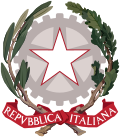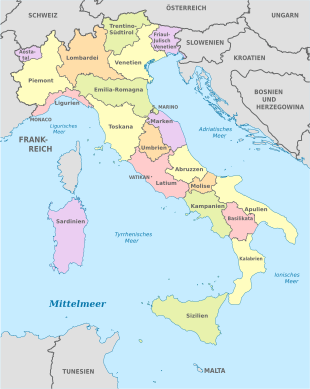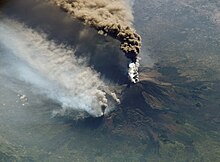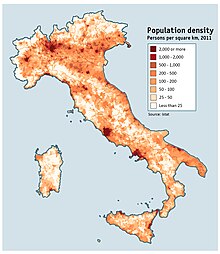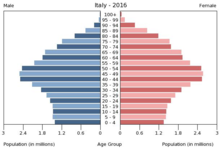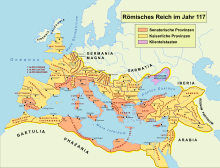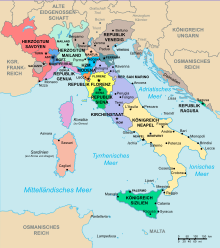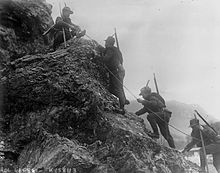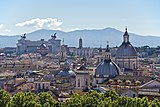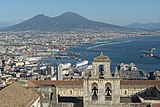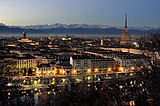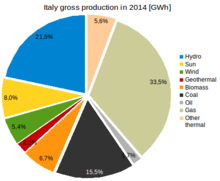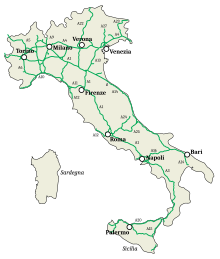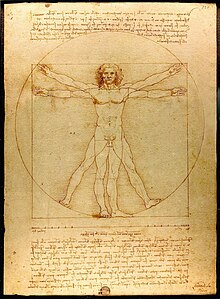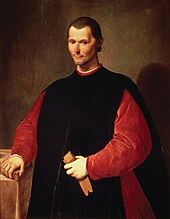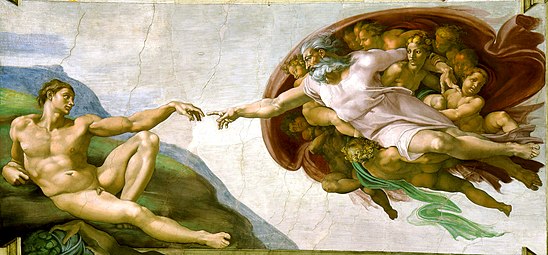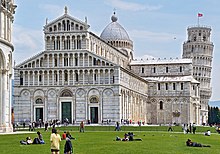Italy
| Repubblica Italiana | |||||
| Italian Republic | |||||
|
|||||
| Official language |
Italian regional also German , French , Ladin and Slovenian 1 |
||||
| Capital | Rome | ||||
| State and form of government | parliamentary republic | ||||
| Head of state |
President Sergio Mattarella |
||||
| Head of government |
Prime Minister Mario Draghi |
||||
| surface | 301,338 km² | ||||
| population | 60,026,546 (June 30, 2020) | ||||
| Population density | 199 ( 40th ) inhabitants per km² | ||||
| Population development | −0.44% (2019/2020) per year | ||||
gross domestic product
|
2019 | ||||
| Human Development Index | 0.892 ( 29. ) (2019) | ||||
| currency | Euro (EUR) 2 | ||||
| founding | 1861 3 | ||||
| National anthem |
Il Canto degli Italiani |
||||
| National holiday | April 25th, June 2nd | ||||
| Time zone |
UTC + 1 CET UTC + 2 CEST (March to October) |
||||
| License Plate | I. | ||||
| ISO 3166 | IT , ITA, 380 | ||||
| Internet TLD | .it | ||||
| Phone code | +39 2 | ||||
|
1For more information, see Languages and Dialects
3 1866 Venice to Italy, 1870 Rome, after the First World War Trento and Trieste
|
|||||
| Italian regions | |||||
Italy ( Italian Italia [ iˈtaːlja ], officially Italian Republic , Italian Repubblica Italiana [ reˈpubblika itaˈljaːna ]) is a state in southern Europe ; its capital is Rome .
Italian territory is for the most part on the Mediterranean enclosed Apennines -halbinsel and the Po Valley and the southern mountainous part of the Alps . The state borders France , Switzerland , Austria and Slovenia . The small states of Vatican City and San Marino are completely enclosed by the Italian national territory. In addition to the large islands of Sicily and Sardinia, there are several archipelagos offshore.
As the crossroads of the Mediterranean civilizations, the Italian contribution to the cultural and historical heritage of Europe and the world is noteworthy.The area of today's Italy was the core region of the Roman Empire in antiquity , Upper Italian Tuscany was the heartland of the Renaissance , followed by Rome the Baroque era .
With the Risorgimento , the modern Italian nation-state came into being: From 1861 to 1946, the Kingdom of Italy existed under the House of Savoy , which was rapidly industrialized , rose to become a major European power and established a colonial empire in North and East Africa from the 1880s . The costly and loss-making participation in the First World War from 1915 to 1918 led to an expansion of the national territory, but also to serious social unrest and paved the way for the Italian fascists under Benito Mussolini to gain power. The fascist regime ruled Italy from 1922 to 1943/45 and led the country into the Second World War in 1940 on the side of the Axis powers . The war defeat led to the loss of the colonies and comparatively minor assignments of territory to the neighboring state of Yugoslavia . In June 1946, a referendum ended the monarchy ; today's republic was proclaimed.
Italy is a co-initiator of European integration and a founding member of the European Union , the Council of Europe and the Latin Union . The country is a member of the G7 , G20 , NATO , the United Nations (UN), the Organization for Economic Co-operation and Development (OECD) and the World Trade Organization (WTO).
According to the Human Development Index, Italy is one of the most highly developed countries in the world as an industrialized country and is the eighth largest economy in the world in terms of nominal gross domestic product . The country enjoys a high standard of living and education, and has one of the highest life expectancies . Italy is the country with the most UNESCO World Heritage Sites (55) and one of the most visited countries in the world with around 65 million tourists annually.
etymology
There are numerous hypotheses for the origin of the word Italia . One of them is that the name is borrowed from the Greek Víteliú ("land of calves" from vitulus "calf"). The Greek historian Dionysius of Halicarnassus makes this claim along with the legend that Italy was named after Italos , who is also mentioned by Aristotle and Thucydides .
According to Antiochus of Syracuse , the Greeks initially only used the term Italy to designate the southern part of the Bruttium peninsula , which corresponds to the region around the present-day municipalities of Reggio and partly Catanzaro and Vibo Valentia . At the time of Antiochus, however, the more comprehensive designation of Oinotria and "Italy" were used synonymously and the name also applied to most of Lucania . According to Strabon's "The Geography", before the expansion of the Roman Republic , the name was used by the Greeks to denote the land between the Strait of Messina and the line connecting the Gulf of Salerno and the Gulf of Taranto . This delimitation roughly corresponds to today's region of Calabria . Little by little the Greeks came to apply the name "Italia" to a larger region. In addition to the hypothesis of "Greek Italy" in the south, historians have suggested the existence of an " Etruscan Italy" covering various areas of central Italy.
In contrast, the borders of Roman Italy, Italia, are better defined. Catos Origines , the first historical work written in Latin , described Italy as the entire peninsula south of the Alps . According to Cato and several Roman authors, the Alps formed the "walls of Italy". In 264 BC Roman Italy stretched from the Arno and Rubicon rivers in the northern center of the peninsula to the entire south. The northern area of Gallia cisalpina , the Gaul on this side of the Alps, was founded in the 220s BC. Occupied by Rome and was geographically and de facto part of Italy. However, it initially remained politically and de jure separate until it was 42 BC. BC by the triumvirate Octavian as implementation of the unpublished Acts of Caesars (Acta Caesaris) was legally incorporated into the administrative unit of Italy. The islands of Sardinia, Corsica, Sicily and Malta were added to Italy by Diocletian in 292 AD .
geography
Italy lies on a peninsula facing from northwest to southeast, the shape of which is reminiscent of a boot. The maximum north-south extension is a little less than 1200 km, in the east-west direction the maximum extension is about 700 km. Bordering countries are France (length of the common national border: 488 km), Switzerland (734.2 km), Austria (430 km), Slovenia (232 km) as well as the enclaves of San Marino (39 km) and the Vatican City (3 km) . The national borders have a total length of about 2000 km. With Campione d'Italia, Italy has an exclave surrounded by Switzerland . Another border is that to Croatia (sea border). The total coastline is 7,600 km.
morphology
The mountain range of the Apennines runs through the country along the longitudinal axis and reaches its greatest height in the Gran Sasso at 2,912 m . In the north, a large part of the Alps belongs to Italy: the highest peak is Mont Blanc (Monte Bianco) at 4,810 m, which lies on the border with France. (The course of the border on Mont Blanc is controversial, however. According to the French view, Mont Blanc de Courmayeur is the highest peak in Italy with its 4,748 m.) The highest mountain massif, which stands entirely on Italian soil, is the Gran Paradiso with 4,061 m in the Graian Alps .
The Italian Riviera in Liguria and the Gulf of Naples in Campania stretch along the west coast from north to south . The east coast from Trieste to the Gargano in northern Apulia (according to other representations: to the Strait of Otranto ) is referred to as the Italian Adriatic coast .
The Po plain (Italian: Pianura Padana ) in the north is the largest plain in Italy with an area of 50,000 km² .
Waters
Hydrographically , Italy belongs almost exclusively to the Mediterranean. Only the valley of the Lago di Livigno and the uppermost part of the Val d'Uina drain over the Inn and Danube into the Black Sea . The Drau , which rises in the Puster Valley in South Tyrol , and the Gailitz , which flows through the area around Tarvisio, also drain there . Furthermore, the valley of the Lago di Lei drains over the Rhine into the North Sea . The longest rivers are the Po (652 km), the Etsch (410 km) and the Tiber (405 km), followed by the Adda and the Oglio . The largest Italian lakes include Lake Garda , Lake Maggiore and Lake Como in northern Italy and Lake Bolsena and Lake Trasimeno in central Italy.
Islands
Italy includes the large Mediterranean islands of Sicily and Sardinia as well as the archipelagos of the Aeolian and Aegadian Islands north and west of Sicily. There are numerous small islands around Sardinia, including Sant'Antioco , Asinara , San Pietro and the La Maddalena archipelago . The Pontine Islands stretch off the coast of Lazio. In the Tyrrhenian Sea there are also the Campania Archipelago (including the islands of Capri and Ischia ), the Tuscan Archipelago (also Elba ) and the Aeolian Islands. The Tremiti Islands are located in the Adriatic Sea . The Pelagic Islands , to which Lampedusa also belongs, and the island of Pantelleria are geologically part of Africa .
geology
Due to the geological conditions, earthquakes occur again and again in Italy . The strongest quake of the 20th century, with a magnitude of 7.2 on the Richter scale, occurred in 1908 in Messina and Reggio Calabria . Around 120,000 people died. In 1915, an earthquake near Avezzano in Abruzzo claimed 30,000 lives. The southern Italian region of Irpinia was hit by several strong earthquakes in 1980, the extensions of which reached from Portici near Naples to Potenza in Basilicata ; 3000 people died in the process. On October 31, 2002, there was a strong earthquake in San Giuliano di Puglia ( Molise region ): 30 people, including 27 children, were buried in the rubble of a collapsed school building. The 1976 Friuli earthquake claimed 965 lives. On April 6, 2009, a severe earthquake with a magnitude of 5.9 on the Richter scale occurred in L'Aquila , claiming 308 victims. In August 2016, a similar earthquake followed in the area of Amatrice .
Volcanoes
In addition to the 1281 meter high Vesuvius , which has been in a dormant phase since the last eruption in 1944, and the Phlegraean Fields with their countless thermal springs and fumaroles , there are several other volcanoes on the Italian islands on the mainland. Most famous are the 3,323 meter high Etna , which last erupted in 2018, and the 926 meter high, constantly active Stromboli . Italy is the country with the most active volcanoes on the European continent.
climate
The climate is subtropical with sometimes very clear differences in the various regions.
Northern Italy is bordered by the Alps and the Tuscan-Emilian Apennines, which limits the influence of the Mediterranean on the climate. The winters are cool, in the cities of the Po Valley there is occasional light frost, and occasionally snow can fall, which can remain overnight or for a few days; In the months of November to January there are often long periods of dense fog in the plain. The summers are long and hot and the humidity is high.
Central Italy has milder winters and dry, warm to hot summers due to the influence of the Mediterranean Sea. Around south of the 45th parallel, wild pine stands can also be found widespread . This typical Mediterranean tree species hardly tolerates temperatures below 0 ° C and immediately begins to die from below, which shows that there are almost no frosts in these areas.
Southern Italy and the Italian islands have a warm, Mediterranean climate almost all year round . Autumn comes late, winters are humid and mild with daytime temperatures of 10 to 15 ° C and spring sets in early ( almond blossom from the end of January). In summer it can get very hot, often temperatures of over 40 ° C are reached. Due to low rainfall in the summer months, periods of drought are a common problem in this region.
In the Alps and the Apennines there is a mostly cold mountain climate due to the altitude , and the summers there are mostly mild.
The mean annual sunshine duration is around 1250 hours in the north, around 1700 hours in the middle (Rome≈1680 hours) and increases to over 2000 hours in the very south and on Sicily .
At the Pala di San Martino in Trentino, a new Italian cold record was measured in December 2010 at −48.3 ° C. The maximum temperature of 48.5 ° C was recorded on August 10, 1999 at the Catenanuova weather station in the province of Enna in Sicily. This is also the highest temperature registered in Europe to date.
The recently accelerated climate change has exacerbated existing environmental problems throughout the Mediterranean, including Italy. For five broad and interconnected areas of impact (water, ecosystems, nutrition, health and safety), current changes and future scenarios consistently point to substantial and increasing risks in the coming decades. In large parts of Italy, rainfall is decreasing, temperatures are rising and extreme weather events are increasing. The consequences of the changes in the Alps are particularly visible. Parts of the Planpincieux glacier of the Grandes Jorasses on the border with France, for example, now threaten to plunge into the valley due to rising temperatures. The consequences can also be seen in agriculture. In the 2018/19 season, the worst olive harvest in 25 years was caught in Italy and the Italian farmers' association is already talking about an "olive oil collapse". In Sicily, because of the changed conditions, farmers have started growing tropical fruits such as mangoes and avocados instead of the native oranges or olives. The climate crisis also threatens the country's cultural heritage. For example, 13 out of 15 UNESCO World Heritage Sites in Italy are threatened by coastal erosion because they are located in the low-lying coastal region.
natural reserve
In 2014 there were 24 national parks in Italy with a total area of around 15,000 km². The Gran Paradiso National Park in the Aosta Valley and Piedmont regions, known for its Alpine ibex population , was the first to be established in 1922. The largest national parks are the Pollino National Park, which extends over 1925 km² in the regions of Calabria and Basilicata and is home to the Italian wolf , the Cilento and Vallo di Diano National Park with over 1810 km² in Campania and the Gran Sasso and Monti della Laga National Park with over 1413 km² in Abruzzo, on whose territory the Corno Grande is the highest peak of the Apennines.
In addition, 134 regional parks have been established with an area of 13,000 km². The largest regional parks include the Parco dei Nebrodi in Sicily with around 860 km², the Adamello-Brenta Nature Park with around 621 km² in the province of Trento in the Southern Alps, whose establishment also serves to protect the last Italian occurrence of Alpine brown bears , as well as the Parco dell'Etna with a unique flora and fauna around the Etna volcano with over 580 km².
In 2009, the Ministry of the Environment listed 871 aree naturali protette .
population
The population of Italy in 1861 was estimated at about 22 million. In 1961 the population was around 51 million. Today Italy has about 60 million inhabitants (as of June 2020) and ranks 23rd in the world rankings, within the European Union the country ranks third behind Germany and France. With a population density of almost 200 inhabitants per km², Italy is one of the countries with a high population density within the European Union . Italy's population roughly doubled over the course of the 20th century. With the beginning of the 21st century, Italy's population is growing very slowly.
| year | population | year | population |
|---|---|---|---|
| 1861 | 22,182,377 | 1951 | 47,515,537 |
| 1871 | 27,303,509 | 1961 | 50,623,569 |
| 1881 | 28,953,480 | 1971 | 54.136.547 |
| 1901 | 32,965,504 | 1981 | 56,556,911 |
| 1911 | 35,845,048 | 1991 | 56.778.031 |
| 1921 | 39,943,528 | 2001 | 56,995,744 |
| 1931 | 41,651,000 | 2011 | 59,433,744 |
| 1936 | 42.943.602 | 2019 | 60.244.639 |
Urban and rural populations
Around 67 percent of the population, mainly in the north, live in cities. From 1950 to 1960 there was a strong rural exodus in particular . Since the 1980s, this trend has been reversed in favor of the suburbs and small towns ( suburbanization ). In the period from 1951 to 1974 there was also a strong internal migration to northern Italy: around four million southern Italians emigrated to the industrial centers in the north.
Life expectancy and health, medical care

Italy has one of the highest life expectancies in the world. In 2016 it was 84.9 years for women and 80.3 years for men. About 19 percent of Italians were over 65 years of age. Italy is one of the oldest societies in the world and will continue to age in the future due to the low fertility rate of 1.4 children per woman.
The mortality from heart and circulatory diseases was 33 per 10,000 inhabitants in 2006; it was 40.5 for men and 27.7 for women. This is one of the lowest rates anywhere in Europe. Cancer diseases follow just behind these symptoms. In 2006 these values were 26.6, with men (37.3) dying from it significantly more often than women (19.4). Vibo Valentia (19.4) and Lodi (33.6) showed extreme values . The metropolises are also above average, especially Naples (29); then follow Milan (28.9), Rome (27.9), Genoa (27.9) and Turin (27.2). The rate for men was particularly high in the Aosta Valley and the Friuli-Venezia Giulia region , and for women in the Province of Trento .
The child mortality rate in Italy was 3.0 ‰ in 2018 (OECD: 6.8 ‰). In terms of child mortality, the rate has been halved since the mid-1990s to 3.4 deaths per 1,000 births within the first year. The average in Europe in 2006 was 4.7. Finland, Switzerland, Slovenia and Luxembourg were between 2.6 and 1.8, Romania on the other hand 11. Within Italy, the province of Enna (7.4) had the highest value, the Aosta Valley (0.8) the lowest.
In Italy, too, as in almost all OECD countries, an increase in the proportion of obese (very overweight) people can be observed. This figure rose from 7.0 percent in 1994 to 9.9 percent in 2005 (in Germany this rate was 13.6 percent in the same year), and has since stagnated at around 10 percent.
The proportion of daily smokers fell from 27.8 percent to 22.3 percent between 1990 and 2005 (OECD: 24.3 percent). Since January 10, 2005, there has also been a general smoking ban in all publicly accessible buildings. Alcohol consumption is also falling.
Italy has seen a decline in the number of doctors per 100,000 population since its peak in 2002. In 2004 there were 416.7 doctors, in 2007 it was only 363.5. Only in Liguria did their number rise from 514.7 to 581.9, making the supply there the densest. Latium followed with 511.1 doctors. In the south, only Sicily was above the national average with 425.
School system and education

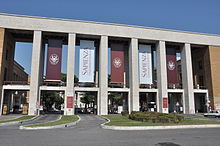
The school system in Italy is - in terms of structure and structure - characterized by great uniformity. The essential provisions for teaching and education are no different in Milan than in Palermo . There are only differences in the area of vocational training, which is part of the competence area of the individual regions. The school system is divided into the following levels: pre-school ( scuola dell'infanzia, formerly scuola materna, three years, 3–6), elementary school ( scuola primaria, formerly scuola elementare, five years, 6–11), middle school ( scuola secondaria di primo grado, formerly scuola media inferiore, three years, 11-14) and high schools ( scuola secondaria di secondo grado, formerly scuola media superiore, five years, 14-19). The state high schools are divided into grammar schools, technical colleges and vocational schools. In the area of grammar schools there is a humanistic, a scientific and a modern language branch ( liceo classico, scientifico, linguistico ) as well as the so-called art high school ( liceo artistico ). The technical colleges ( istituto tecnico ), which lead to the general university entrance qualification and also to a vocational qualification, are divided into several training directions, in which numerous specializations are offered. The area of vocational training is covered on the one hand by the state vocational schools ( istituto professionale ), at which a professional qualification can be obtained after three years, and the higher education entrance qualification after two further years. On the other hand, there are the vocational training centers ( centro di formazione professionale ) maintained or supervised by the Italian regions .
The compulsory education in Italy is a compulsory education has become, which was gradually increased. In the past it was eight years (6-14), with which the elementary and middle school became compulsory school ( scuola dell'obbligo ). At the end of the 1990s, it was increased to nine years. In 2004, a twelve-year school and vocational training requirement was introduced. After completing secondary school, this can be achieved either by attending state secondary schools or regional vocational schools. Alternatively, in-company training can also be carried out, with courses at regional vocational schools also having to be completed. If the training courses at regional vocational training centers are completed with a state examination, the path to the vocational high school diploma is free. Anyone who attains a first professional qualification before the age of 18 is exempted from twelve years of compulsory education and training.
Italy has made significant progress in foreign language training: English is taught in elementary school, and a second living foreign language can be learned from middle school (from the 6th school year). The five-year high schools see i. d. R. Latin lessons before, with the ancient language Liceo Classico , ancient Greek is added.
The PISA studies from other members of the Italian school as a whole is a relatively poor marks. In 2009 Italy achieved 486 points in reading, 483 in mathematics and 489 in science. However, there is also a sharp north-south divide in Italy in the school system: the Lombardy region achieved 526 points in the natural sciences, while Calabria only achieved 443 points. In 2012, Italy improved insignificantly, but the regional differences remained almost unchanged. The PISA results in German-speaking schools in South Tyrol in reading competence (503), mathematics (513) and natural sciences (530) were above average.
In the higher education sector, unlike in the German-speaking countries, there are no independent universities of applied sciences. As a result, the rate of people with a university degree is lower than elsewhere in the European Union and is around 15 percent. With the Bologna Process , the division into a three-year bachelor's degree ( laurea triennale or laurea breve ) followed by a two-year master's degree (laurea magistrale, formerly laurea specialistica) was also created at Italian universities . Jura is offered as a five-year laurea magistrale . As far as higher education institutions are concerned, one can make the following distinctions:
- Università : universities in the classic sense;
- Politecnici : Technical Universities;
- Scuole superiori : Top universities that promote talented students. The best known is the Scuola Normale Superiore in Pisa, usually just called Normale , which was founded by Napoleon;
- Istituti di alta formazione artistica e musicale : art and music colleges that are not actually universities but belong to higher education;
- Istruzione e formazione tecnica superiore : the higher vocational education system.
67 of the 95 universities in Italy are public. The best-known private universities are the Bocconi in Milan and the LUISS in Rome. The University of Bologna is the oldest university in the world, it was founded in 1088. A total of 1,809,186 students are enrolled in Italian universities. In 1960/61 there were only 217,000. The La Sapienza University in Rome is one of the largest universities in Europe with almost 114,000 students.
Relatively new is the expansion of the old people's colleges and adult education centers (università per la terza età).
Religions
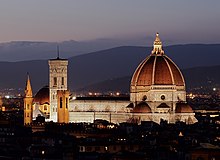
Italy is a Roman Catholic country with a high density of Roman Catholic institutions. In 2000 there were 227 dioceses, 252 bishops officiated, of which 224 were local and 26 auxiliary bishops. Article 7 of the Constitution of Italy regulates the relationship between the state and the Roman Catholic Church. The Roman Catholic Church in Italy is traditionally influential, which earlier correlated with a high number of priests. In addition to 34,300 diocesan, around 2005 there were 21,450 religious priests. The number of priests has long been falling. In 1871 it was 109,688, but between 1991 and 2004 it fell from 57,200 to 51,600, that of religious men from 5,000 to 3,500, and that of women religious from 125,800 to 102,300.
51 million (85 percent) of the people living in Italy professed the Roman Catholic faith in 2008. The second largest Christian denomination was therefore the Orthodox Church with 1,187,130 followers. Their share has increased significantly due to the immigration of Romanians . The third largest Christian religious community is Jehovah's Witnesses with over 251,000 active members (missionaries, also known as “publishers”) and almost 2900 assemblies. It is also the largest community in Europe of this special Christian community . Around 550,000 people felt they belonged to Protestant religious communities (including Waldensians and Baptists ).
The enclave of the State of Vatican City , which is the center of the Roman Catholic Church, is located in Rome, the capital of Italy . The Pope is also its head of state, the head of the Roman Catholic Church and the Bishop of Rome . The Holy See as a non-governmental, independent subject of international law distinguishable from the State of Vatican City represents the miniature state at the international level.
Among the non-Christians, Muslims , mostly immigrants from Muslim countries, were the largest religious community with 1,293,704 (see also Islam in Italy ). In addition, there were 197,931 Buddhists and 108,950 Hindus in Italy . The Jewish community numbers around 45,000, but in 2009 there were only 24,400 members as immediate members of a community.
In 2008, four million people did not confess to any denomination.
According to a representative survey by the Eurobarometer , 74% of people in Italy believed in God in 2005, 16% believed in a spiritual force . 6% percent of those questioned believed neither in a god nor in any other spiritual force, 3% were undecided.
Languages and dialects

In addition to the official Italian language, there are the regional official languages German and Ladin in Trentino-South Tyrol , French in the Aosta Valley and Slovenian in Friuli-Venezia Giulia .
In addition, a state law from 1999 provides for the protection of the following minority languages:
- Albanian (see Arbëresh ), distributed throughout the Mezzogiorno
- Franco-Provençal , the actual vernacular of the Aosta Valley and some valleys in Piedmont with small linguistic islands in Apulia
- Furlan , the language of Friuli
- Greek (see Griko ) in Apulia and Calabria
- Catalan in Alghero in Sardinia
- Molise- Croatian in the Molise region
- Occitan in the southern Alpine valleys of Piedmont
- Sardinian , the language of Sardinia.
So far, this law has not been implemented, with a few exceptions. The establishment of multilingual offices, mother tongue schooling and the promotion of radio and television programs, as provided for by the law, have not been implemented. Some progress has only been made in the naming of places: Numerous traffic signs in Friuli also have the Furlanic name, while in Sardinia the Italian place name may also be used in addition to the Sardinian place name. In the schools of Friuli it is also possible to take lessons in Furlanic.
Heel talisman and Cimbrian are Bavarian dialects that are common in some language islands in northeast Italy. In Trentino they are protected as minority languages. In some alpine valleys in the northwest, the highest Alemannic dialect of the Walser is spoken, which is recognized and promoted in the autonomous region of Aosta Valley .
In addition, numerous dialects of Italian are spoken in Italy . These can be divided into three major dialect groups:
- Northern Italian dialects : These include the Galloital dialects (especially Piedmontese and Lombard ) and the Venetian ;
- Tuscan dialects;
- Central and southern Italian dialects: These include the Roman dialect and Sicilian .
The recognition of dialects as independent languages is controversial in linguistics, as well as in politics. For example , the traffic signs in some municipalities, especially those administered by the Lega Nord , have been expanded to include the local dialect.
immigration
| rank | Country | population |
|---|---|---|
| 1. |
|
1,207,919 |
| 2. |
|
440.854 |
| 3. |
|
432,458 |
| 4th |
|
305.089 |
| 5. |
|
240,428 |
| 6th |
|
169.137 |
| 7th |
|
161.101 |
| 8th. |
|
147,872 |
| 9. |
|
136.113 |
| 10. |
|
127.101 |
The number of foreigners living in Italy has been increasing steadily since the 1990s. According to the national statistics institute ISTAT , as of December 31, 2019, there were 5,306,548 foreign nationals residing in Italy, representing 8.8 percent of the total population.
In addition, around 120,000 Roma live in Italy , 70,000 of whom are citizens.
The illegal immigrants are not included in the statistics. The OECD estimates between 500,000 and 750,000, while Caritas assumes that there are a million foreigners in the country without a residence permit. This would mean that there would be up to 6 million foreigners in Italy.
Most of the immigrants are located in the north and in the center of Italy, where they make up 10.1 percent and 9.7 percent of the population, respectively. In the southern Italian regions, the proportion of foreigners is 2.9 percent. The cities with the largest proportion of foreigners in 2009 were: Rome (242,725), Milan (181,393), Turin (114,710), Genoa (42,744), Florence (40,898), Bologna (39,480), Verona (34,465), Brescia ( 31,512), Padua (25,596), Naples (24,384), Reggio Emilia (24,401), Prato (24,153), Venice (23,928) and Modena (22,857). The number of Arabs in Italy is estimated at 692,201.
Italians abroad
Between 1876 and 1915 Italy was affected by one of the largest waves of emigration . An estimated 14 million citizens left the country to seek their fortune mainly in America - in the United States as workers, in Argentina and Brazil as farmers. With a population of 33 million at the turn of the century, this corresponds to almost a third of the population. 1913 was the year with the highest recorded number of emigrants: over 870,000 Italians left their homeland.
The fascist dictatorship tried to counteract emigration, but could not prevent another 2.6 million Italians from leaving the country. Argentina and France in particular were preferred emigration countries between the world wars, especially since the United States and Brazil had introduced stricter immigration rules.
After the Second World War, emigration increasingly turned towards European countries. Many who had temporarily gone to Belgium, Germany, France and Switzerland as guest workers settled in their host countries for an indefinite period of time.
There are still 4,106,640 Italians abroad registered in the consular register of persons. The following table shows the countries (except Italy) in which most of the Italian citizens are resident.
Italian citizens living abroad are allowed to vote in the parliamentary elections in Italy and are represented by twelve MPs and six senators. They are also allowed to take part in national referendums .
| Country | population |
|---|---|
|
|
659,655 |
|
|
648.453 |
|
|
533.821 |
|
|
343.197 |
|
|
297.137 |
|
|
251.466 |
|
|
199.284 |
|
|
187.363 |
|
|
124.133 |
|
|
122,863 |
|
|
121,465 |
|
|
104,637 |
|
|
90.231 |
|
|
48,966 |
|
|
32,730 |
| other states | 341.239 |
| Country | Of Italian origin | Proportion of the population |
|---|---|---|
|
|
25 million | about 60 percent |
|
|
25 million | about 13-14 percent |
|
|
17.8 million | about 6 percent |
|
|
3.5 million | about 5 percent |
|
|
1.7 million | about 6 percent |
|
|
1.5 million | about 4.5 percent |
|
|
1 million | about 29 percent |
|
|
850,000 | about 4 percent |
|
|
800,000 | <5 percent |
|
|
650,000 - 700,000 | <1 percent |
|
|
550,000-700,000 | about 8 percent |
|
|
500,000 | about 3 percent |
|
|
300,000 - 500,000 | <1 percent |
|
|
290,000 | about 3 percent |
|
|
120,000 | about 3 percent |
|
|
100,000 | about 1.5 percent |
- Source: Italian Ministry of Foreign Affairs
history
Prehistory and early history
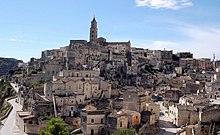
The history of Italy in the sense of a hominid settlement of the Apennine peninsula and the islands surrounding it can be traced back 1.3 to 1.7 million years, with modern humans appearing in Italy around 43,000 to 45,000 years ago and several millennia alongside the Neanderthals lived. Until the 6th millennium BC Hunting, fishing and gathering formed the basis of existence.
About 6100 BC BC first groups brought agriculture with them from outside the peninsula, probably by sea from southern Anatolia and the Middle East , and the hunters and gatherers disappeared. In the 2nd millennium, a development began that turned the villages into early town-like settlements, and the societies showed clear traces of hierarchies for the first time .
The history of Italy, documented by written sources , only begins after the colonization by Italian peoples . Alongside them, the Etruscan culture , whose origin is unclear, experienced around 600 BC. Their heyday. In the 8th century BC The Greek colonization of the southern Italian mainland and Sicily had begun, Phoenicians settled on the west coast of the island . These colonies later belonged to Carthage .
Antiquity
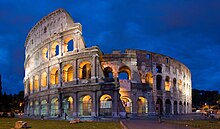
Italy, especially central ( Etruria ) and southern Italy ( Magna Graecia ), was an important European cultural center as early as pre-Roman times . From the 4th century BC BC began the expansion of Rome , 146 BC. Chr. Were Corinth and Carthage destroyed, the conquest of the Mediterranean, and later parts of central and northern Europe brought cultural influences and people from across the kingdom and neighboring areas to Italy. The peninsula formed the center of the Roman Empire and remained so, with some restrictions, until the fall of Western Rome around 476. In the process, the agrarian economic base, which had initially consisted of peasants, was transformed into a system of spacious latifundia based on slave labor . A dense road network connected the expanding cities, thanks to which the exchange of goods, but also the dependence on external goods such as wheat and olive oil from North Africa, increased.
In late antiquity , alongside slavery and the free peasants in the country, forms of attachment to the land appeared, such as the colonate , although a distinction was still made between free and unfree colonies around 500 ( Colon Edict of Anastasius ). In the 4th century Christianity established itself as the state religion.
After all, for centuries it was the center of the Roman Empire. 41 BC The Italian heartland, which previously reached as far as the Rubicon near Rimini, was expanded to include the province of Gallia cisalpina . Sicily and Sardinia (as well as Corsica) were only annexed to the mother country Italy ( Dioecesis Italiae ) in the course of Emperor Diocletian's territorial reform .
middle Ages
After the invasion of the Goths and the Lombards (410 and 568 respectively) the country split up into a number of domains. In the 8th and 9th centuries, especially under Pippin and Charlemagne, the Franks dominated, but under the successors of Charlemagne, a separate kingdom of Italy developed. Since Otto the Great , Italy has mainly belonged to the Holy Roman Empire ( Imperial Italy ), the south remained Byzantine for a long time . However, from 827 onwards, the Arabs conquered Sicily and parts of southern Italy.
In the 11th century, the Norman conquest of southern Italy took place over a period of several decades . Due to the boom in trade and transport, the cities of northern Italy in particular gained increasing independence in the 11th century. The Normans and numerous cities in Northern Italy supported the Pope during the investiture dispute between 1076 and 1122.
With the fall of the Staufer dynasty in 1268 their attempts to renew the dwindling imperial power in Italy failed, although Henry VI. the Lower Italian Norman Empire had won through marriage. The French Anjou dynasty ruled the south from 1268 onwards . The north was divided into a number of formally belonging to the Holy Roman Empire, but otherwise independent cities with their surrounding areas.
Renaissance
The Renaissance began in Italy in the late fourteenth century ; the 15th and 16th centuries are considered to be the core period. The essential characteristic is the rebirth of the ancient spirit, humanism was the formative intellectual movement. In addition, there was a reorientation in science, where the theocentric worldview of the Middle Ages was replaced by a more anthropocentric view of things.
In the 14th and 15th centuries, powers emerged with enormous economic and cultural advantages. This was especially true for the independent powers of Italy, i.e. the Duchy of Milan , the republics of Venice and Florence , the Kingdom of Naples and the Papal States , but also for the courts of Ferrara and Mantua . The cities shared political power and resources of the Italian peninsula in changing coalitions and offered relatively great political freedom, which inspired new scientific and artistic paths. The great fortunes generated by trading made it possible to commission large public and private art projects. In addition, the development towards pragmatic writing experienced an upswing in the early 13th century, the correspondence of merchants deepened and broadened literacy, so that the number of people literate increased.
In the 15th century Italy was one of the most urbanized regions in Europe.
Modern times
16th to 18th century
The decline of Italy began immediately after the discovery of America, with the shift of trade to the overseas colonies of Western European states, also in view of the Ottoman control over the Mediterranean. Politically, Italy became a plaything for foreign powers. In the 16th century, France and Spain fought for supremacy on the peninsula. The Battle of Pavia (1525) sealed the supremacy of Spain, which was able to secure direct control of southern Italy and Lombardy. In 1797 the Cisalpine Republic was formed from the states of the Cispadan Republic and the Transpadan Republic , which existed until 1805.
In 1796 French revolutionary troops took power ( Italian campaign ). In 1805 Napoleon was crowned King of Italy ( Kingdom of Italy ) in Milan . After the end of his rule , Italy fell under the influence of the Austrian Empire . From the 16th to the 19th century, most of Italy was under foreign rule.
19th century
The Italian national movement in the 19th century is often referred to as the Risorgimento . Under the leadership of the Savoy dynasty , kings of Sardinia-Piedmont , driven by the voluntary associations under Giuseppe Garibaldi , Italy was unified in three wars of independence (1848 to 1870). On March 17, 1861, Victor Emanuel II was proclaimed King of Italy in Turin ( Kingdom of Italy ). In 1865 the capital moved to Florence . In 1866, with the Third War of Independence , the previously Austrian Veneto and Friuli became part of the Kingdom of Italy.
Rome was conquered in September 1870 and became the country's capital in 1871. In addition, Italy tried to gain a foothold as a colonial power in the Horn of Africa ( Eritrea colony from 1890; Ethiopia ) and in Libya (see also Italian colonies ). Many other European powers then looked back on a long colonial history ; In contrast, Italy (like the German Empire ) had no colonies in 1871.
World War I, Fascism and World War II
Italy joined the Triple Entente in 1915 , although it was a member of the Triple Alliance (with the German Empire and Austria-Hungary ) . After the Entente promised territorial gains in the secret London treaty (see Italy's war aims ), the kingdom was able to annex Venezia Giulia , Istria, Trentino and German-speaking South Tyrol on the side of the victorious powers .
In October 1922, Benito Mussolini and his followers ( Fascisti ) took power after the march on Rome . Step by step, Mussolini transformed the kingdom into a totalitarian state and put himself at the head of the state as Duce (leader). On October 3, 1935 , Italy invaded the Abyssinian Empire (now Ethiopia ) and annexed the country. This illegal occupation was part of Mussolini's declared aim to revive the ancient Roman Empire . Mussolini allied himself with the German Reich and Adolf Hitler through various agreements (e.g. in the so-called Steel Pact , May 1939). Finally, Italy entered World War II on the side of Germany and Japan (Berlin-Rome-Tokyo axis) in June 1940 .
On July 10, 1943, the Western Allies began their Italian campaign ; under the impression of severe defeats, Mussolini was deposed and captured by the Fascist Grand Council on July 25, 1943 with a simple majority. King Victor Emmanuel III took over the supreme command of the armed forces and commissioned Marshal Pietro Badoglio to form a military government. Badoglio declared the fascist party and its branches dissolved by law. On September 8, the Badoglio government concluded the Cassibile armistice with the Allies . Italy withdrew from the Tripartite Pact . The war had cost Italy about 198,500 lives since 1940.
The subsequent invasion of the German Wehrmacht (" Fall Axis ") met with resistance from the Resistance . The German Reich tried to bring the black shirts back to power and had Mussolini liberated in the company Eiche on September 12, 1943 . Northern Italy was occupied by German troops as far as Rome and a government under Mussolini was established in this area, which proclaimed the Italian Social Republic (Republic of Salò) . This parallel government remained allied with Germany, declared war on the part of Italy occupied by the Allies and waged war against Italian partisans in northern Italy .
As a result, central Italy in particular was devastated by heavy fighting along the advancing front. The civilian population became the target of German reprisals (→ German war crimes in Italy ). As a result, the Badoglio government declared war on Germany on October 13, 1943, which dragged on for the last 18 months until the end of the war. When the German units withdrew to the Goth line in the Apennines in June 1944 and Italian partisans stepped up their attacks on German soldiers, further massacres of the civilian population occurred (e.g. the massacre of Sant'Anna di Stazzema , the massacre of Marzabotto ) and other serious war crimes by the German occupiers and troops of the fascist social republic. On April 29 and May 2, 1945, Army Group C surrendered to the Western Allies .
post war period

After the end of the war, Italy lost its own colonies - Italian Somaliland was an exception insofar as the UN gave administrative control of this former colony to Italy for another ten years in 1950 . The Italian metropolitan area was spared major territorial cedings (the majority of Julisch Venetia was ceded to Yugoslavia or today's Slovenia and Croatia , the Italian Dodecanese to Greece , the municipalities of Tende and La Brigue to France).
A constituent assembly passed the new Costituzione della Repubblica Italiana on December 22, 1947. This constitution came into force on January 1, 1948.
The post-war history of Italy is characterized domestically by frequent changes of government, but until 1990 four decades under the leadership or main participation of the Democrazia Cristiana ( Christian Democrats ), foreign policy by the founding membership in the European Economic Community and economically by the economic miracle (miracolo economico) . After decades of high inflation (the lira , Italy's former currency, lost much of its value), new borrowing was slowed down significantly in the 1990s in order to meet the Maastricht criteria and introduce the euro as a currency.
At the beginning of the 1990s, the country's political elite was replaced by the Tangentopoli corruption scandal and the educational measures of the legal investigations of the Mani pulite .
presence
From around 1994 to the end of 2011, Italy's politics were determined by party alliances around Silvio Berlusconi and changing center-left coalitions. In 2011, Mario Monti became his successor, in particular as a result of the euro crisis that had been smoldering since 2009 and Italy's national debt , which was criticized as being too high , and formed a cabinet of independent experts ( Cabinet Monti ). It was followed by the Letta cabinet (April 28, 2013 to February 22, 2014) and this was followed by the Renzi cabinet under Matteo Renzi .
A constitutional amendment sought by Renzi was rejected by the people in a referendum on December 4, 2016 , as a result of which Renzi resigned. The new Prime Minister was Paolo Gentiloni . After the 2018 elections , a coalition government of the Movimento 5 Stelle and Lega Nord parties was formed under the non-party Prime Minister Giuseppe Conte , which took office on June 1, 2018. After Lega Nord left the coalition, Conte reorganized his cabinet , which was supported by Partito Democratico , Liberi e Uguali , Italia Viva and the Movimento Associativo Italiani all'Estero in addition to MoVimento 5 Stelle . In January 2021, Italia Viva left the government alliance and Conte announced his resignation.
President Sergio Mattarella spoke out against new elections during the COVID-19 pandemic , which has affected Italy since January 2020, and instructed Mario Draghi , the former President of the European Central Bank and former Governor of the Italian Central Bank, to form a government that will take place on Was sworn in on February 13, 2021. This government of national unity is supported in particular by the Movimento 5 Stelle , Partito Democratico , Lega and Forza Italia parties .
politics
Founding of the state

On June 2, 1946, the Italians were called to a referendum on the form of government and elections to the Constituent Assembly.
28,005,449 Italian citizens were eligible to vote, of whom 24,946,878 voted, which corresponds to 89.1% of the eligible voters. For the first time women were also allowed to vote . The official result was announced on June 18, 1946 by the Court of Cassation: 54.27% of the votes for the republic , 45.73% for the monarchy , and 1,509,735 invalid votes (1,146,729 of which are blank ballots).
Regarding the regional majority, Italy was practically divided into two camps: in the north the republic had won with 66.2%, in the south the monarchy came with 63.8%.
Political system
Italy has been a parliamentary republic since 1946 . The Italian constitution , originally called La Costituzione della Repubblica Italiana , was passed on December 22, 1947, came into force on January 1, 1948 and is characterized by a compromise character that stems from the immediate post-war history: from the experience of the common resistance struggle against fascism ( Resistancea ) decided the anti-fascist (liberal, socialist, communist and Catholic) parties united in the “National Liberation Committee” to work out the new constitution together.
Special features of the Italian Constitution, the central role of the Parliament ( bicameral , bicameralismo perfetto is granted), the relatively few formal influence of the Prime Minister , the strong emphasis plebiscitary elements (constitutional amendments may have to carry referendum to be confirmed, there is also for the citizens of the possibility to make use of referendums and legislative initiatives), the powerful constitutional court and the decentralization in the course of reforms in the 1990s and early 2000s.
Italy is a member of several supranational organizations . On April 4, 1949, she joined NATO . Italy has been a member of the United Nations since December 14, 1955 . The country is also a founding member of the European Union on January 1, 1952.
executive


The government is officially called the Council of Ministers (Italian: consiglio dei ministri or simply consiglio ), the Prime Minister operates as President of the Council of Ministers , in Italian that is, presidente del consiglio (dei ministri) . If one only speaks of the "President", both the State President and the Prime Minister can be meant.
The ministers are jointly responsible for the actions of the Council of Ministers and individually for the actions of their portfolio. The ministers are appointed by the President of the Republic on the proposal of the Prime Minister. The Prime Minister does not have the power to appoint or dismiss ministers independently.
The Prime Minister determines the general policy of the government and takes responsibility for it. He maintains the uniformity of the direction in politics and administration by promoting and coordinating the activities of the ministers. Because of the dependency on the often unstable political majority, the Prime Minister, as the “Chairman of the Council of Ministers”, is often viewed only as primus inter pares .
As a collegiate body, however, the Council of Ministers plays a prominent role in the Italian constitutional system, particularly in the legislative process :
- he prepares bills ,
- he enacts legislative decrees, which must then be converted into laws by parliament so that the legislative decrees retain their effectiveness,
- it is mandated by parliament to draft laws within certain framework conditions through empowering laws and can, in this respect, issue so-called legal decrees.
The official seat of the Italian Prime Minister is the Palazzo Chigi in Rome . There he is supported by the Presidency of the Council of Ministers . The acting Prime Minister of Italy has been Mario Draghi since February 13, 2021 .
legislative branch

The Italian Parliament consists of two chambers: the Senate ( Senato della Repubblica ) and the Chamber of Deputies ( Camera dei deputati ). Both chambers have absolutely equal rights in the legislative process and only differ in terms of the number, composition and mode of election of their members. Both chambers meet independently of each other. In each chamber there are standing committees and special commissions, which are also independent of one another.
The Chamber of Deputies is the larger parliamentary chamber, whose 630 members (including 12 representatives of Italians living abroad ) are elected every five years.
The Senate of the Republic has 315 senators. They are also elected (at the same time as the MPs) for five years, but not on a national level, but on a regional basis. Each of the 20 regions has a fixed number of senators, which varies according to the population in the region.
In addition, there are a maximum of five senators appointed by the President for life . In addition, the state presidents are also legally senators for life after the end of their term of office. Currently (December 2020) there are six senators in parliament for life, five of which are presidential-appointed senators and one is a former president.
As a result of a constitutional reform that was adopted in a referendum in 2020 , the parliament will be reduced in size from the next legislative period (to 400 members and 200 elected senators).
Head of state
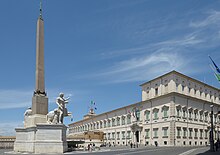
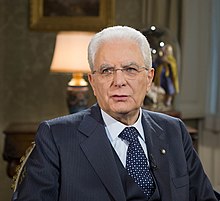
The head of state in Italy is the president (actually: President of the Republic, Italian : Presidente della Repubblica ). According to the constitutional norm, he predominantly performs representative functions, participates in the formation of a government and is commander in chief of the armed forces . In the constitutional reality, it often plays a decisive role in overcoming government crises, which were much more frequent in the Italian Republic in the second half of the 20th century than in other European countries.
Its main power is to dissolve parliament (one or both). However, he may not exercise these in the last six months of his mandate, unless they fully or partially coincide with the last six months of the legislative period.
He has another important role in relation to legislation. Since every law requires the signature of the state president before it can be promulgated, he can at least temporarily prevent it from coming into force. If Parliament approves the law again, the Italian Constitution will force it to sign it. So he does not have a real right of veto.
The President is elected by the united chambers of parliament ( parlamento in seduta comune ) and representatives of the 20 regions: three per region, with the exception of the Aosta Valley , which can only send one representative. The election of the president takes place by secret ballot with a two-thirds majority of the assembly. After the third ballot, an absolute majority is sufficient. Any citizen who has reached the age of 50 can be elected. The official seat of the President is the Quirinal Palace in Rome. Sergio Mattarella has been the incumbent President of the Italian Republic since February 3, 2015 .
Political indices
| Name of the index | Index value | Worldwide rank | Interpretation aid | year |
|---|---|---|---|---|
| Fragile States Index | 42.4 out of 120 | 143 of 178 | Stability of the country: more stable 0 = very sustainable / 120 = very alarming |
2020 |
| Democracy index | 7.74 out of 10 | 29 of 167 | Incomplete democracy 0 = authoritarian regime / 10 = complete democracy |
2020 |
| Freedom in the World Index | 89 of 100 | - | Freedom status: free 0 = not free / 100 = free |
2020 |
| Freedom of the press ranking | 23.69 out of 100 | 41 of 180 | Satisfactory situation for freedom of the press 0 = good situation / 100 = very serious situation |
2020 |
| Corruption Perceptions Index (CPI) | 53 of 100 | 52 of 180 | 0 = very corrupt / 100 = very clean | 2020 |
Law
The Italian legal system is assigned to the Roman-Germanic legal system and can look back on a history reaching back from the Middle Ages to Roman law .
In addition to the Italian Constitution ( Costituzione della Repubblica Italiana , 1948), the most important sources of law are the Civil Code ( Codice civile , 1942), the Code of Civil Procedure ( Codice di Procedura Civile , 1940), the Criminal Code ( Codice penale , 1930) and the Code of Criminal Procedure ( Codice di Procedura Penale , 1988). In addition, there are numerous codifications (Codici) and uniform texts (Testi Unici) in individual legal areas (from labor law to administrative law).
The highest organ of ordinary jurisdiction in Italy is the Court of Cassation ( Corte Suprema di Cassazione ), the Constitutional Court ( Corte Costituzionale ) is responsible for constitutional jurisdiction.
General active suffrage for men had been in effect since 1919. In the spirit of feminist reforms, the House of Commons ( Camera dei deputati ) also voted 174 to 55 in 1919 for active suffrage for women , but the Senate ( Senato del Regno ) refused to endorse the measure . On May 15, 1925, Mussolini appeared in person in Parliament to support a bill that would give women local suffrage. In the same year, however, he abolished all local elections. In 1945 the Christian Democrats and the Communists introduced a bill to introduce universal suffrage. All other parties supported it and it became law on February 1, 1945. The following year was elected. According to Article 3 of Decree 23 of January 30, 1945, visible sex workers (i.e. those who carried out their trade outside of licensed brothels) were excluded from the right to vote, so that the right to vote for women was restricted. The passive right to vote for women was also introduced on February 1, 1945, the same restrictions applied as for active women s right to vote . Article 7 of Decree 74 of March 10, 1946 confirms the eligibility of citizens who are 25 years old on election day, i.e. without restrictions.
Health system
The health system in Italy is structured at regional level. The local sanitary companies ( Aziende Sanitarie Locali ) are subordinate to the respective regional governments. The regional characteristics mean that the quality of the services varies greatly from region to region. There is a sharp north-south divide, which is causing a strong health tourism, especially in the direction of Veneto, Lombardy and Emilia-Romagna.
The excellent performance of these regions led the WHO in 2000 to place Italy in second place after France in the world ranking of health systems. The long waiting times (often several months) for inpatient treatment are seen as negative.
General practitioners in Italy receive a flat rate per capita for patients who are registered in a list. Dental services must also be borne entirely by the citizens themselves.
Total health expenditure in 2019 was 8.7 percent of GDP , exactly in line with the OECD average. The majority of this expenditure (75 percent) is borne by the public sector (OECD: 71.7 percent).
Police and intelligence services
The Italian police system is multilayered and partly organized militarily. The individual police organizations are subordinate to different ministries or the lower regional authorities. This traditional system has been preserved for reasons of tradition, but also to prevent too much police force from being bundled in one hand or in one ministry. At the national level there is the civil Polizia di Stato (State Police), which is subordinate to the Ministry of the Interior. It mainly takes on police tasks within the big cities.
The state police are supplemented by the Carabinieri , a gendarmerie force that reports to the Ministry of Defense and, according to the instructions of the Ministry of the Interior, provides police services, especially in rural areas. Similar structures can also be found in France ( Gendarmerie nationale ) and Spain ( Guardia Civil ). In addition, the Italian Ministry of Finance has the Guardia di Finanza (Finance Watch), a finance and customs police that also takes on border protection tasks. At the local level there are, among other things, the municipal police force ( Polizia Municipale ), which mainly take care of local road traffic.
In Italy, the Prime Minister has been directly responsible for the intelligence services since 2007 and sets operational priorities in cooperation with the interministerial steering committee Comitato interministeriale per la sicurezza della Repubblica (CISR). The Dipartimento delle Informazioni per la Sicurezza (DIS), subordinate to the Prime Minister, coordinates the work of the foreign intelligence service Agenzia Informazioni e Sicurezza Esterna (AISE) and the domestic intelligence service Agenzia Informazioni e Sicurezza Interna (AISI). There is also the military specialist service Centro Intelligence Interforze (J2) , which is part of the General Staff . The intelligence services have been controlled by a special parliamentary committee since 1977.
military
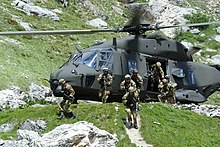
Italian security policy is still based on integration into NATO , EU and UN as well as on the strategic partnership with the USA. Italy sees itself as the main actor in the extended Mediterranean region ("mediterraneo allargato"). In terms of security policy, Italy focuses on the situation in Libya and the refugee crisis. In the area of disarmament, Italy advocates worldwide compliance with the treaties, including the ban on cluster bombs. It supports the initiative to create a world free of nuclear weapons.
The Italian armed forces consist of the branches Esercito Italiano ( Army ), Marina Militare ( Navy ) and Aeronautica Militare ( Air Force ) as well as the Carabinieri . Currently (2019) around 171,000 soldiers serve in the armed forces, plus around 110,000 Carabinieri and around 30,000 civilian employees.
The general conscription is exposed in Italy since July 1 of 2005. When the army, navy and air force were converted to a professional and volunteer army, they were set at a total of 190,000 soldiers. Because of the financial and economic crisis that followed, cuts and downsizing also had to be made in the armed forces. In 2019, defense spending totaled around 21.4 billion euros, which corresponds to 1.21 percent of gross domestic product.
By 2024, the strength of the armed forces (excluding the Carabinieri) is expected to drop to 150,000 soldiers and 20,000 civilian employees. The focus of the armed forces on foreign missions within the framework of the EU, NATO and the United Nations was somewhat restricted in the 2015 Defense White Paper.
The inventory of US nuclear weapons on Italian territory has been significantly reduced since the end of the Cold War. The United States is still storing atomic bombs in Aviano , and others have been assigned to an Italian squadron in Ghedi as part of nuclear participation .
Foreign and Security Policy
Italy is a founding member of both the European Union and the Council of Europe . As an EU member, the Italian Republic also joined the European Monetary Union in 1990 and is part of the European internal market . The euro has been legal tender in Italy since 2002, replacing the Italian lira . In the Campione d'Italia exclave, it is not the euro but the Swiss franc that is legal tender. In addition to economic interests, it is also active in other EU policy areas, for example Italy is part of the Schengen area , judicial and police cooperation in Europe with the help of Europol and Eurojust . Italy is one of the most integration-friendly member states of the EU. The process of EU enlargement to include new members (especially the Western Balkans and Turkey) is actively supported by Italy. Italy is committed to further deepening the European Union. A particular concern of Italy's European policy is the establishment of a viable mechanism based on the principle of solidarity for the sustainable management of the refugee crisis.
The regional focal points of Italian foreign policy include the Mediterranean region, the Western Balkans, the Middle East, Afghanistan, the Horn of Africa with a special focus on the former colonies, as well as Latin America with its high number of Italian emigrants and their descendants (Uruguay, Argentina, Brazil , Venezuela). Due to its central location, Italy also sees itself as a bridge between Europe and the southern Mediterranean countries, namely Libya, Egypt and Tunisia. Italy is very concerned about the large number of refugees, most of whom reach Italy and the EU via Libya. In relation to Russia, with which there are intensive economic ties, Italy is committed to maintaining the dialogue even in the current tense situation.
Italy is involved in many UN missions and is one of the largest providers of troops.
State budget

The state budget included expenditures in 2019 of 871 billion euros and revenues of 842 billion euros: The budget deficit of about 29 billion euros corresponded to 1.6% of GDP . In 2010 the new debt was 4.2%, the national debt was 1,839.2 billion euros or 116.6% of GDP.
Much of the debt arose during the 1980s and early 1990s: in 1979 the debt was still 62.4%, in 1994 it was 124.5%, but fell back to below 100% in the following years. In 2014, a record high of 135.4% was achieved. At the end of 2019, the national debt was 2,409.9 billion euros or 134.7% of GDP. The ECB's monetary policy has enabled Italy to replace some of its high-yield government bonds with lower-yield new government bonds when they mature.
| year | 2008 | 2009 | 2010 | 2011 | 2012 | 2013 | 2014 | 2015 | 2016 | 2017 | 2018 | 2019 |
|---|---|---|---|---|---|---|---|---|---|---|---|---|
| Public debt as% of GDP | 106.2 | 116.6 | 119.2 | 119.7 | 126.5 | 132.5 | 135.4 | 135.3 | 134.8 | 134.1 | 134.4 | 134.7 |
| Budget balance as% of GDP | −2.6 | −5.1 | −4.2 | −3.6 | −2.9 | −2.9 | −3.0 | −2.6 | −2.4 | −2.4 | −2.2 | −1.6 |
The share of government expenditure (in% of GDP) was in the following areas:
Public revenue, taxes, levies
The share of public revenue in GDP (tax ratio in the broader sense) is 43 percent (as of 2010), well above the OECD average of 33.8 percent (as of 2009); for comparison: Germany 36.3 percent and Denmark 48.2 percent (both as of 2010).
The tax rate (not to be confused with the share of public burdens in GDP or the tax rate in the narrower sense) is 29.4 percent (as of 2010) in the top third in an international comparison; for comparison: Germany 22.1 percent (as of 2010).
The most important taxes are:
- the IRPEF (income tax for natural persons), which ranges in 4 different rates from 23 percent to 43 percent;
- the IRES (corporate income tax), with a flat rate of 27.5 percent;
- the IVA (sales tax), which is usually 22 percent, exceptionally 10 percent or 4 percent;
- the IRAP (the regional value added tax), the standard rate of which is 3.9 percent and is roughly comparable to the German trade tax .
- the IMU (Municipal Real Estate Tax), entered into force with Art. 13 of the Emergency Ordinance No. 201/2011, transformed into Law No. 214/2011 (Monti Decree)
The tax rate (in the narrower sense) is 13.6 percent of GDP (as of 2010).
EU contribution payments
In 2008 Italy was the third largest contributor to the European Union after Germany and France , with over 15 billion euros, which made up 13.6 percent of the total EU budget. If one calculates the payments received against it, Italy was the second largest net payer of the Union after Germany and before France with 4.1 billion.
In 2009 the country was the third largest net contributor behind the Federal Republic and France with 5.06 billion. In 2010, the United Kingdom became the second largest contributor, with Italy now in fourth place with 4.53 billion.
Political structure
Politically, Italy is divided into 20 regions ( regioni ), each with its own government . These regions are divided into a total of 88 provinces ( province ) and 14 metropolitan cities (città metropolitane) . Provinces and metropolitan cities are subdivided into a total of 7,904 municipalities (comuni) .
Regions
The Italian regions have a national constitution known as a statute. Five regions have a special statute ( statuto speciale ) that grants them different degrees of autonomy; these are marked with an asterisk (*) in the following list.
| region | Capital | Residents | Area (km²) | Inhabitant / km² |
|---|---|---|---|---|
|
|
Milan | 9,781,682 | 23,863 | 408 |
|
|
Naples | 5,815,251 | 13,590 | 428 |
|
|
Rome | 5,650,977 | 17,236 | 326 |
|
|
Palermo | 5,037,499 | 25,711 | 196 |
|
|
Venice | 4,899,371 | 18,399 | 266 |
|
|
Turin | 4,440,226 | 25,402 | 174 |
|
|
Bologna | 4,357,164 | 22,446 | 194 |
|
|
Bari | 4,079,638 | 19,358 | 211 |
|
|
Florence | 3,720,366 | 22,994 | 161 |
|
|
Catanzaro | 2,007,997 | 15,081 | 133 |
|
|
Cagliari | 1,670,539 | 24,090 | 69 |
|
|
Genoa | 1,615,441 | 5,422 | 298 |
|
|
Ancona | 1,573,445 | 9,366 | 166 |
|
|
L'Aquila | 1,338,103 | 10,763 | 124 |
|
|
Trieste | 1,232,291 | 7,858 | 157 |
|
|
Trento | 1,022,528 | 13,607 | 75 |
|
|
Perugia | 897.611 | 8,456 | 106 |
|
|
Potenza | 589,632 | 9,995 | 59 |
|
|
Campobasso | 320.360 | 4,438 | 72 |
|
|
Aosta | 127,430 | 3,263 | 39 |
|
|
Rome | 60.177.551 | 301,338 | 199 |
Cities
List of ten largest cities by population.
| Most populous cities in Italy | ||||||
|---|---|---|---|---|---|---|
| Settlement area | city | Agglomeration | Area (km²) | |||
| 1 | Rome | 2,872,800 | 4,355,725 | 5,351 | ||
| 2 | Milan | 1,366,180 | 3,234,658 | 1,575 | ||
| 3 | Naples | 966.144 | 3,101,002 | 1,171 | ||
| 4th | Turin | 882.523 | 2,269,120 | 2,297 | ||
| 5 | Palermo | 668.405 | 1,260,193 | 4,992 | ||
| 6th | Genoa | 580.097 | 844,957 | 1,839 | ||
| 7th | Bologna | 389.261 | 1,011,291 | 3,702 | ||
| 8th | Florence | 380,948 | 1,013,260 | 3,514 | ||
| 9 | Bari | 323,370 | 1,257,520 | 3,821 | ||
| 10 | Catania | 311,620 | 1,109,888 | 3,552 | ||
| As of December 31, 2017 | ||||||
Provinces and metropolitan cities
| rank | Metropolitan area | Population (2007) |
Area in km² |
Density in inhabitants / km² |
|---|---|---|---|---|
| 1. | Milan | 8,047,125 | 8,362.1 | 965.6 |
| 2. | Naples | 4,996,084 | 3,841.7 | 1,300.5 |
| 3. | Rome | 4,339,112 | 4,766.3 | 910.4 |
| 4th | Venice - Padua - Verona | 3,267,420 | 6,679.6 | 489.2 |
| 5. | Bari - Taranto - Lecce | 2,603,831 | 6,127.7 | 424.9 |
| 6th | Rimini - Pesaro - Ancona | 2,359,068 | 5,404.8 | 436.5 |
| 7th | Turin | 1,997,975 | 1,976.8 | 1,010.7 |
| 8th. | Bologna - Piacenza | 1,944,401 | 3,923.6 | 495.6 |
| 9. | Florence - Pisa - Siena | 1,760,737 | 3,795.9 | 629.8 |
| 10. | Messina - Catania - Syracuse | 1,693,173 | 2,411.7 | 702.1 |
The province of Sassari is the largest province in terms of area with 7,678 km². The provinces of Bolzano ( South Tyrol ) and Trento ( Trentino ) have a special position in the constitution. They are on an equal footing with the autonomous provinces and the Italian regions.
economy


Italy is an industrial state with a previously strongly controlled economy : the state-owned company IRI (1933–2002) had 1,000 subsidiaries and had up to 500,000 employees. In the course of the 1990s, the state-owned companies were gradually privatized , also to service the public debt, the markets were opened and deregulated .
Italy's gross domestic product totaled 1,787.66 billion euros in 2019. This corresponds to around 29,600 euros per person . This made Italy the fourth largest economy in the EU after Germany , Great Britain and France and (2019) the eighth largest economy in the world.
It should also be noted that the black economy has traditionally been very high in Italy. The revenue agency estimates its share of GDP at between 16.2 and 17.5 percent (2008), other observers assume up to 30 percent. The fact is that when calculating GDP, the shadow economy is taken into account on the basis of estimates.
Economic growth has been below the EU average for over a decade. This applies to both the years before and after the financial crisis around 2007. Real gross domestic product fell by a total of almost 3 percent between 2004 and 2016. In particular, after the crisis-related decline in GDP of 5.5 percent in 2009, economic output barely recovered in the years that followed and fell noticeably again in 2012 and 2013. In 2015 and 2016, real GDP grew by just under 1 percent compared to around 2 percent in the EU as a whole.
Italy's most important trading partner is Germany, with an export share of 12.7 percent and an import share of 15.9 percent, followed by France with 11.2 percent and 8.5 percent respectively. The most important export markets for Italian products also include Spain (6.5 percent), the USA (6.2 percent) and the United Kingdom (5.2 percent). Italy also obtains most of its imports from China (6.2 percent), the Netherlands (5.3 percent), Libya (4.6 percent) and Russia (4.2 percent).
In the Global Competitiveness Index , which measures a country's competitiveness, Italy ranks 30th out of 141 countries (as of 2019). In 2020, the country was ranked 74th out of 180 countries in the Index for Economic Freedom . The cumbersome bureaucracy in Italy is seen as an obstacle to greater competitiveness and economic freedom.
raw materials
Italy has a wide variety of raw material deposits. The country's important mineral resources are fluorite , coal , mercury , sylvine and zinc . The world-famous Carrara marble is quarried in the Apuan Alps around Carrara and Massa . There are large reserves of natural gas ( Po Valley , Adriatic Sea ) and oil ( Basilicata , Sicily ).
power supply
The energy supply in Italy is characterized by a very high dependency on imports, approx. 79 percent of the energy demand is imported.
The consumption of electrical energy in Italy in 2011 was 334.6 TWh, which represents an increase of 1.3 percent compared to the previous year. More than 10 percent is produced by hydropower , with the share of energy production from renewable energies increasing by 7.8 percent in 2011 compared to the previous year.
Today, Italy mainly produces its electricity in thermal power plants, 64.4 percent of which is produced with natural gas , the rest with oil and other fuels. The largest power plant, Alessandro Volta, is located in Montalto di Castro and has an output of 3,600 MW . In 2009 the power plant only ran for 2000 to 3000 hours (out of a possible 8,760) because the electricity it produces is too expensive.
The proportion of photovoltaics increased by 268 percent in the course of 2011 and reached an annual production of 19.7 TWh in 2017, while the wind turbines (mainly in Apulia and the rest of the south) delivered around 10 TWh. Geothermal energy is generated particularly in central Italy, for example in Larderello , and produced 4.3 TWh. In 2011, Italy among the member states of the European Union provided a significant share of the supply from renewable energy sources with its hydropower: 45.2 TWh were generated - this corresponds to around 15 percent of the total energy generated from hydropower in the EU countries.
Italy had four nuclear power plants before 1990 . Triggered by the Chernobyl catastrophe in Ukraine (April 26, 1986), Italy implemented a step - by- step nuclear phase-out from 1987 onwards . In 1990 the last Italian nuclear power plant was shut down.
After the Fukushima nuclear disaster in Japan, the Italian cabinet decided in March 2011 to suspend a return to nuclear energy for another year; On June 12 and 13, 2011, in a referendum with 57 percent turnout, 94.1 percent of those who voted rejected re-entry.
Italy is now the world's largest net importer of electricity; in the first half of 2014 around 15 percent of demand was imported (22.3 TWh for a total demand of 153 TWh); a large part of it comes from French nuclear power plants. In 2012, a total of 43.104 billion kWh were imported net , of which 24.668 billion from Switzerland and 11.37 billion from France. Electricity prices in Italy are among the highest in the EU for industrial customers.
The largest energy producers are Enel , Edison , ERG , A2A and Sorgenia , while Terna is responsible for the distribution network.
Agriculture, Industry and Services
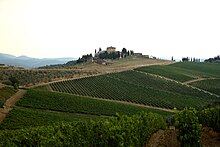
Agriculture plays only a minor role in the economy (approx. 2 percent), but it produces some important products. Important are the wine-growing as the country with around 49 million hectoliters ahead of France's largest wine producer in the world (as of 2015) is, and the production of olive oil : Italy here is the second largest producer (after Spain), with 442,000 tonnes in 2013 and cheese production ( parmesan , mozzarella , pecorino or ricotta ). Also, citrus fruits such as oranges and lemons , nightshade plants like tomatoes and aubergines , cucurbits , such as zucchini , water and honey melons , lettuces like arugula and radicchio , and legumes and nuts fruits grown and exported.
The strength of the Italian economy lies in the manufacturing sector , especially in small and medium-sized family-run companies. According to the central statistics institute ISTAT , 95.2 percent are among the smallest companies with fewer than 10 employees. The Italian company with the highest turnover is the oil and gas company ENI .
The most important industries include the machine , aircraft ( Leonardo ), ship ( Fincantieri ) and vehicle construction ( Fiat group (belonging to: Alfa Romeo , Iveco , Lancia , Maserati ), Ferrari , Piaggio and Pirelli ), the chemical industry and the Manufacture of electronic products ( Magneti Marelli ). The textile industry is very well represented and with its well-known brand names ( Armani , Benetton , Diesel , Dolce & Gabbana , Gucci , Prada or Versace ) it stands for the epitome of made in Italy . Luxottica is the world's largest eyewear manufacturer. The most important Italian export goods also include products from the food industry ( Barilla , Campari , Lavazza , Parmalat ). The largest company in the sector is Ferrero .
In the service sector, Italy is represented internationally primarily by major banks such as Unicredit and Intesa Sanpaolo . The Assicurazioni Generali is one of the largest insurance companies in the world.
The tourism industry has been one of Italy's major sources of income for decades. Italy is one of the classic travel destinations in the world. Popular destinations are the Alps , the coastal areas on the Ligurian and Adriatic Seas , numerous historical cities, museums, archaeological excavation sites and traditional customs such as the Carnival in Venice , Palio di Siena or Calcio storico .
Italy, which was still the most visited country in the world in the 1970s, is now in 5th place with around 65 million tourists (2019) (behind France, Spain, the United States and China).
labour market
Italy saw a sharp decline in unemployment figures at the beginning of the 21st century compared to the 1990s. However, after the outbreak of the financial crisis in 2007 and the subsequent euro crisis, the country is in a crisis. According to ISTAT , the unemployment rate in 2008 was 6.7 percent. In the following years, the unemployment rate in Italy rose steadily and significantly due to the economic crisis. The unemployment rate in the fourth quarter of 2015 was now 11.9 percent. The employment rate in January 2016 was 56.8 percent. Youth unemployment was a high 39.3 percent in January 2016. Compared to 2014, however, these figures represent an improvement. The OECD also found that earned incomes were among the lowest among industrialized countries. The average net income of Italians was only $ 19,861, which is also overtaken by Greeks and Spaniards. The OECD average is $ 24,660.
The self-employment rate is all the higher in Italy. It is around 33 percent of the labor force (compared to 17 percent in Spain and 10 percent in Germany).
In 2011, 3.9% of all workers worked in agriculture, 28.3% in industry and 67.8% in the service sector. The total number of employees is estimated at 25.94 million for 2017; 42% of them are women. The employment rate of women is among the lowest in the European Union.
Regional differences
North-South divide
| Region ( NUTS 2013) |
GDP (€ million) |
GDP per capita (in €) |
GDP PPP (€ million) |
GDP per capita PPP |
|
|---|---|---|---|---|---|
| (in €) | Index (EU 28 = 100) |
||||
| Northwest Italy | 536602 | 33,300 | 550.832 | 34,200 | 118 |
| Piedmont | 127,365 | 28,900 | 130,743 | 29,600 | 103 |
| Aosta Valley | 4,374 | 34,200 | 4,490 | 35,100 | 122 |
| Liguria | 47,663 | 30,200 | 48,927 | 31,000 | 107 |
| Lombardy | 357.200 | 35,700 | 366,672 | 36,600 | 127 |
| Northeast Italy | 376.925 | 32,300 | 386.919 | 33,200 | 115 |
| South-Tirol | 21,488 | 41,300 | 22,058 | 42,400 | 147 |
| Trentino | 18.608 | 34,600 | 19.102 | 35,500 | 123 |
| Veneto | 151,634 | 30,800 | 155,655 | 31,600 | 110 |
| Friuli Venezia Giulia | 35,669 | 29,100 | 36,615 | 29,900 | 104 |
| Emilia-Romagna | 149,525 | 33,600 | 153,490 | 34,500 | 119 |
| Central Italy | 355.006 | 29,400 | 364.419 | 30,200 | 104 |
| Toscana | 110,332 | 29,400 | 113.257 | 30,200 | 105 |
| Umbria | 21,438 | 24,000 | 22.007 | 24,600 | 85 |
| Brands | 40,593 | 26,200 | 41,670 | 26,900 | 93 |
| Lazio | 182,642 | 31,000 | 187.486 | 31,800 | 110 |
| Southern Italy | 255.557 | 18,100 | 262,333 | 18,600 | 64 |
| Abruzzo | 32,592 | 24,500 | 33,456 | 25,200 | 87 |
| Molise | 6,042 | 19,300 | 6,202 | 19,800 | 69 |
| Campania | 100,544 | 17,200 | 103.210 | 17,600 | 61 |
| Apulia | 72,135 | 17,700 | 74,048 | 18,100 | 63 |
| Basilicata | 11,449 | 19,900 | 11,752 | 20,400 | 71 |
| Calabria | 32,795 | 16,600 | 33,664 | 17,100 | 59 |
| Islands | 119,864 | 17,800 | 123.042 | 18,200 | 63 |
| Sicily | 87,383 | 17,200 | 89,700 | 17,600 | 61 |
| Sardinia | 32,481 | 19,600 | 33,342 | 20,100 | 70 |
| Italy as a whole | 1,645,439 | 27,100 | 1,689,072 | 27,800 | 96 |
| EU total | 14,714,029 | 28,900 | 14,714,029 | 28,900 | 100 |
| Source: EUROSTAT Newsrelease , 52/2017 - March 30, 2017 | |||||
The economic division of the country into two parts is characteristic of Italy. The heavily industrialized north contrasts with the underdeveloped south.
The major economic centers of Milan, Turin and Genoa form the triangolo industriale ( industrial triangle ). The entire northern Italian region has a well-developed service sector and is one of the economically strongest areas in Europe. Before the financial crisis , there was largely full employment (unemployment rate in 2008 of 3.9 percent), after which the unemployment rate rose to 6.2 percent (2010). However, numerous small and micro-enterprises find it difficult to assert themselves in the globalized market against competition from low-wage countries. On the other hand, industrial sectors such as electrical engineering and mechanical engineering are competitive. Italy is the fourth largest manufacturer of mechanical engineering products, ahead of France and Great Britain, with a world market share of 7.5 percent.
Central Italy has an economy based on businesses in the textile, shoe and furniture sectors, and especially tourism. In addition, Rome is the seat of all administrations, many large companies ( Eni , Enel , Finmeccanica , Poste Italiane , Telecom Italia , Unicredit ) and organizations ( FAO ) and the heart of the Italian film industry ( Cinecittà ). Unemployment in central Italy averaged 8.1 percent in 2010.
The south of the country, also known as Mezzogiorno , is one of the structurally weakest regions in Western Europe. The result is very high unemployment rates (over 13 percent), which is extreme for young people - seasonally adjusted youth unemployment exceeded 40 percent in 2011 in southern Italy . Also an increased crime rate and, last but not least, organized crime , which controls many branches of the economy especially in Campania , Calabria and Sicily .
Furthermore, a study of the development of companies, employees and company sizes in Italy in the 1970s has made it clear that a special industrial structure is developing in the regions of the western Po Valley and along the Via Emilia with their traditionally highly networked and urbanized structures Has. Since the 1970s, the north-east and center of Italy have been summarized under the technical term Third Italy , which describes the Italian industrial districts that clustered in this area.
Social differences
Italy is a country that is not only characterized by strong local differences, but also has a relatively unequal distribution of income . In the list of countries by income distribution , Italy ranks 52nd with a Gini coefficient of 36, one place behind Great Britain. For comparison, Germany ranks 14th, Austria 19th and Switzerland 37th.
According to a study by Bank Credit Suisse from 2017, Italy was the country with the seventh largest national total wealth in the world. Italians' total holdings of real estate, stocks, and cash totaled $ 10,853 billion. The wealth per adult person is $ 223,572 on average and $ 124,636 in median (Germany: 203,946 and 47,091 dollars, respectively). The Gini coefficient for wealth distribution was 71.9 in 2016, which indicates a medium wealth inequality.
According to Forbes (2015), eyewear manufacturer Leonardo Del Vecchio is the richest Italian with a fortune of 22 billion dollars, followed by Maria Franca Fissolo, the widow of confectionery manufacturer Michele Ferrero and the pharmaceutical entrepreneur Stefano Pessina . The richest Italians also include the fashion designer Giorgio Armani , media entrepreneur and politician Silvio Berlusconi and the Benetton family . In 2019, Giovanni Ferrero took first place with a fortune of $ 22.4 billion.
Key figures
| year | 2006 | 2007 | 2008 | 2009 | 2010 | 2011 | 2012 | 2013 | 2014 | 2015 | 2016 | 2017 | 2018 | 2019 |
| Change in% yoy | 2.0 | 1.5 | −1.1 | −5.5 | 1.7 | 0.6 | −2.8 | −1.7 | 0.1 | 0.8 | 1.1 | 1.7 | 0.8 | 0.3 |
| absolute (in billions of euros) | per inhabitant (in thousands of euros) | ||||||||||
|---|---|---|---|---|---|---|---|---|---|---|---|
| year | 2014 | 2015 | 2016 | 2017 | 2018 | year | 2014 | 2015 | 2016 | 2017 | 2018 |
| GDP in billions of euros | 1,622 | 1,652 | 1,690 | 1,727 | 1,756 | GDP per inhabitant (in € thousand) | 26.7 | 27.1 | 27.7 | 28.4 | 29.1 |
| in billion euros and its change compared to the previous year in percent | ||||||
|---|---|---|---|---|---|---|
| 2016 | 2017 | 2018 | ||||
| Billion euros | % yoy | Billion euros | % yoy | Billion euros | % year-on-year | |
| import | 367.6 | −0.8 | 401.5 | +9.2 | 424.0 | +5.6 |
| export | 417.3 | +1.2 | 449.1 | +7.6 | 462.9 | +3.1 |
| balance | 49.7 | 47.6 | 38.9 | |||
| Export (in percent) to | Import (in percent) of | ||
|---|---|---|---|
|
|
12.6 |
|
16.6 |
|
|
10.5 |
|
8.6 |
|
|
9.2 |
|
7.3 |
|
|
5.2 |
|
5.4 |
|
|
5.0 |
|
4.9 |
|
|
4.9 |
|
4.5 |
|
|
2.9 |
|
3.8 |
| other countries | 49.7 | other countries | 48.9 |
traffic
Road traffic
The length of the road network in 2009 was 182,136 km. Of this, 6,621 km were motorways, most of which are privately owned and toll roads . All other roads are public property. A distinction is made between state, regional, provincial and municipal roads. The most heavily used motorways are the A1 from Milan to Naples , the A4 from Turin via Milan and Verona to Venice , the A14 from Bologna to Taranto and also the Brenner motorway A22 , which runs from Modena to the border with Austria . After four years of construction, the A34 between Gorizia and Villesse in Slovenia was completed in 2013 . It is 17 kilometers long and replaces the old R17.
Road traffic in the country is considered largely safe. In 2013 there were a total of 6.1 road deaths for every 100,000 inhabitants in Italy. For comparison: In Germany there were 4.3 dead in the same year. A total of 3,750 people were killed in traffic. The country has a high rate of motorization by global standards. In 2016 there were 707 vehicles for every 1,000 inhabitants in the country (in Germany there were 610 vehicles).
Rail transport

The length of the rail network in 2009 was 20,255 km, of which around two thirds were electrified. Both the network and the transport are in the hands of the state, with a few exceptions (cf. Vinschgau Railway , Ferrovia Trento – Malè ). In the 2017 financial year, the state-owned company Ferrovie dello Stato Italiane posted a profit of 552 million euros. Since 2012, the private railway company Italo - Nuovo Trasporto Viaggiatori has also been offering high-speed connections between some major cities.
In a European comparison, the prices for rail travel in Italy are lower. A single trip from Milan to Venice (267 km) with the Frecciarossa currently costs 45 euros (2018), while the Paris-St. Pierre des Corps (253 km) with the TGV 57 euros, for the route Frankfurt-Göttingen (240 km) with the ICE 66 euros.
With the opening of the last remaining sections between Novara and Milan and between Bologna and Florence in December 2009, Italy now has a 1,000 km long continuous high-speed route from Turin via Milan, Bologna, Florence, Rome and Naples to Salerno. In addition to the above-mentioned north-south axis, a west-east axis between Genoa, Milan, Brescia, Verona, Venice and Trieste is being planned, of which the sections Milan-Brescia 2016 and Padua-Venice 2007 were completed during the opening the Genoa-Milan route is planned for 2022. For southern Italy, new and upgraded lines between Palermo, Catania and Messina as well as between Naples and Bari are planned in the medium term. In the long term, a connection between Naples and Calabria is to be created. The original plan with a connection from the mainland to Sicily, for which the construction of the bridge over the Strait of Messina would have been necessary, was discarded for financial reasons, but is still the subject of discussions. In addition, various international connections to France ( Mont-Cenis base tunnel with connection to the TGV network, opening presumably in 2030) as well as via Switzerland ( NEAT ) and via Austria to Germany ( Brenner base tunnel , opening presumably in 2026) and Slovenia are being considered. In contrast to Germany, the regular track is on the left.
The Milan Subway offers with a length of 98.6 km, the expanded best metro network in Italy. Other metro systems are in Rome , Naples , Turin , Genoa , Catania and Brescia .
shipping
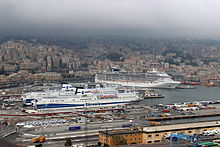
The total length of the navigable waterways is 2,400 km.
The ports of Messina and Reggio Calabria record the highest passenger flow , especially since it is the most important connection between Sicily and the mainland, but also La Spezia . All connections in the Mediterranean are guaranteed by the shipping company Tirrenia di Navigazione , based in Naples. Italy has an extensive network of container ports, with the port of Gioia Tauro moving around 3,445,337 containers in 2007. In addition to these, the ports of Genoa , Trieste and Taranto are also important, the latter specializing in the iron trade.
The main naval arsenals are located in Augusta , Brindisi , La Spezia, and Taranto.
From Trieste , Bari and Ancona there are direct connections to the Albanian port city of Durrës (ital. Durazzo ). There is also a direct connection from Brindisi to Vlorë (Valona) in southern Albania.
aviation

| Item | Airport | region | Code (IATA) |
Number of passengers | Change percent (vs. 2018) |
|---|---|---|---|---|---|
| 1 | Rome Fiumicino | Lazio | FCO | 43,532,573 | +1.3 |
| 2 | Milan Malpensa | Lombardy | MXP | 28,846,299 | +16.7 |
| 3 | Bergamo-Orio al Serio | Lombardy | BGY | 13.857.257 | +7.1 |
| 4th | Venice Tessera | Veneto | VCE | 11,561,594 | +3.4 |
| 5 | Naples-Capodichino | Campania | NAP | 10,860,068 | +9.3 |
| 6th | Catania-Fontanarossa | Sicily | CTA | 10.223.113 | +2.9 |
| 7th | Bologna Borgo Panigale | Emilia-Romagna | BLQ | 9,405,920 | +10.6 |
| 8th | Palermo-Punta Raisi | Sicily | PMO | 7,018,087 | +5.9 |
| 9 | Milan Linate | Lombardy | LIN | 6,570,984 | −28.8 |
| 10 | Rome Ciampino | Lazio | CIA | 5,879,496 | +0.7 |

The largest airline is Alitalia , in the course of whose restructuring the air traffic in Malpensa was severely restricted in favor of Fiumicino. Lufthansa is also active on the Italian flight market: Air Dolomiti , a subsidiary of the German airline, operates numerous flights, mainly between northern Italy, Munich and Frankfurt.
Culture
The Italian contribution to the cultural and historical heritage of Europe and the world is noteworthy. As the crossroads of the Mediterranean civilizations, the center of the Roman Empire , the seat of the papacy and the cradle of the Renaissance , Italy played a decisive role and became the starting point for European art, culture and research.
The emigration of numerous Italians in the 19th and 20th centuries also helped establish Italian culture.
Italy has an estimated total of 100,000 monuments of all kinds (museums, castles, statues, churches, galleries, villas, fountains, historic houses and archaeological finds). It is the country with the most UNESCO World Heritage Sites (55), including 50 World Heritage Sites and five World Natural Heritage Sites. The world heritage sites in Italy range from individual buildings to entire core cities to thematically overlapping groups such as the rock carvings of Valcamonica , prehistoric pile dwellings , the places associated with the rule of the Lombards or a group of late Baroque cities .
The Ministry of Cultural Assets, Cultural Activities and Tourism (Ministero dei Beni e delle Attività Culturali e del Turismo) is responsible for state promotion of culture. The priorities of Italian foreign cultural policy are the cultural program work (carried out by 83 state cultural institutes worldwide) and the promotion of the Italian language (through the 489 branches of the Dante Alighieri Society worldwide, 401 abroad and 88 in Italy).
Traditions and Folklore

In Italy there are numerous historical and folkloric traditions of various kinds, which are also known and famous internationally. Worth mentioning here are the Palio di Siena horse races , the Calcio storico in Florence and the Regata storica in Venice. The carnivals in Venice , Viareggio, Ivrea, Mamoiada, Acireale, Sciacca, Florence and Rome. The rites of the Holy Week in some parishes, as well as various traditions such as the Infiorata di Genzano , the Giostra del Saracino in Arezzo, the Festa dei Ceri in Gubbio and the Giostra della Quintana in Foligno.
UNESCO has counted the processions with shoulder shrines ( Macchina di Santa Rosa in Viterbo , Varia di Palmi in Palmi , Gigli di Nola in Nola and Faradda di li Candareri in Sassari ) and the Sicilian Marionette Theater since 2001 as part of the intangible cultural heritage of humanity .
kitchen
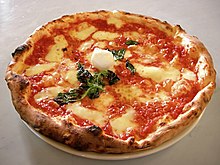
Italian cuisine ( Cucina italiana ) is one of the most influential national cuisines in the world.
Internationally known products include Italian olive oil , pesto , ice cream , panettone , tiramisu , various types of cheese such as Parmesan , mozzarella or Gorgonzola , sausage and meat products such as mortadella , salami , San Daniele ham or Parma ham and of course pasta and pizza . There is also the rich local wine selection such as Chianti and Barolo .
In Italy, food is an important aspect of everyday life and the care of the kitchen is an indispensable part of the national culture. The Italian cuisine was in 2010 as a world intangible cultural heritage by UNESCO.
In 1953 the Accademia Italiana della Cucina was founded in Milan . This would like to preserve the knowledge of the Italian cuisine and table culture and pass it on to the following generations. To this end, it organizes meetings and conferences, has set up the Franco Marenghi Study Center and awards prizes and awards. The Academy publishes the monthly magazine Civiltà della Tavola . Another project to initially preserve the Italian culinary art, the Associazione Slow Food , was founded in 1986 in Bra by Carlo Petrini .
According to a survey carried out by the Goethe Institute in 2013, Italian cuisine was considered to be the best cuisine in Europe by 42 percent of the participants. The survey, carried out in 24 languages and 30 countries, was headed “What does Europe mean to you personally?”.
Occasionally, the high life expectancy is attributed to the Mediterranean diet , which contains a lot of fish , olive oil , fruit and vegetables , for example . Italian cuisine consists of a large number of regional cuisines and can fall back on a large number of ingredients and specialties.
science
Perhaps the most famous polymath and humanist in history, Leonardo da Vinci has made multiple contributions to a wide variety of fields including painting , sculpture , architecture , anatomy , mechanics , engineering, and natural philosophy . One of the most important founders of the modern exact natural sciences , Galileo Galilei was an astronomer , physicist , mathematician , engineer , cosmologist , philosopher and started a scientific revolution.
Other well-known Italian scientists of the Renaissance were Leon Battista Alberti , writer, mathematician, art and architecture theorist as well as architect and medalist . Pietro Bembo , groundbreaking was his theory of Italian literary language. It contributed to the fact that the "language dispute" over the question of which variant of Italian is best suited as a literary language was decided in favor of Tuscan.
Here is a brief overview of other well-known personalities in science: the astronomer and mathematician Giovanni Domenico Cassini ; the physicist Alessandro Volta , inventor of the electric battery and co-founder of the theory of electricity, the mathematicians Lagrange (born Giuseppe Lodovico Lagrangia), Fibonacci and Cardano ; Guglielmo Marconi , Nobel Prize Winner in Physics, co-inventor of radio; the physicist Enrico Fermi , also Nobel Prize winner, known for nuclear research; the navigator Christopher Columbus , who discovered America in 1492; Luigi Luca Cavalli-Sforza , population geneticist and founder of the Human Genome Project (HGP).
medicine
Between 995 and 1087 the medical teaching and research institute Schola Medica Salernitana developed into one of the first and most important medical institutions of the Middle Ages. Systematic gynecology was founded in the 12th century with the collective manuscript Trotula .
Notable medical scientists and discoveries in the following centuries: in the 16th century Gabriele Falloppio describes the structure of the fallopian tubes; 1665 describes Marcello Malpighi , who is considered the founder of plant anatomy and comparative physiology , as well as microscopic anatomy, the capillary circulation, the theory of the functioning of the lungs and the structure of the kidney corpuscles; Giovanni Battista Morgagni , founder of modern pathology ; Giovanni Maria Lancisi , whose scientific achievements include findings on hygiene , flu , rinderpest and, above all, malaria ; In 1854 Filippo Pacini discovered the bacterium Vibrio cholerae as the causative agent of cholera ; In 1893, Bartolomeo Gosio isolated the first antibiotic from a mold ; and Lazzaro Spallanzani , whose pioneering discoveries lie in the field of physiology.
In the 20th and 21st centuries, well-known physicians such as Camillo Golgi (who discovered the Golgi apparatus named after him ), Daniel Bovet , Salvador Luria , Renato Dulbecco , Rita Levi-Montalcini and Mario Capecchi were awarded the Nobel Prize for Physiology or Medicine .
literature
The hymn Canticle of the Sun by Francis of Assisi is considered the oldest evidence of Italian literature. With his work Divine Comedy, the Florentine Dante Alighieri laid the foundations of the modern Italian language and one of the greatest works in world literature . The poet Francesco Petrarca was the actual founder of Renaissance humanism and made the sonnet known as a poem form. He wrote numerous Latin works. His cycle of poems, Canzoniere , written in Italian , is considered to be the most important post-antique collection of poems in European literature. Giovanni Boccaccio wrote the Decamerone , a collection of 100 short stories that are embedded in a framework. These three, namely Dante, Petrarca and Boccaccio, were also known as the three Florentine crowns ( Le tre corone fiorentine ).
The Enciclopedia Italiana di scienze, lettere ed arti ( Enciclopedia Italiana or Enciclopedia Treccani for short ) was published in the first edition, consisting of 35 text volumes and an index volume, between 1929 and 1937 by the Istituto dell'Enciclopedia Italiana and is a multi-volume universal encyclopedia in Italian . The publishing house, founded in 1925, is also the publisher of the national biography Dizionario Biografico degli Italiani .
The great Italian writers also include Ludovico Ariosto , Giambattista Basile , Umberto Eco , Carlo Goldoni , Giacomo Leopardi , Alessandro Manzoni , Giambattista Marino , Torquato Tasso and Emanuele Tesauro .
Italian Nobel Prize winners in literature are the poet Giosuè Carducci (1906), writer Grazia Deledda (1926), playwright Luigi Pirandello (1936), poet Salvatore Quasimodo (1959), Eugenio Montale (1975) and the satirist, playwright and actor Dario Fo (1997) .
philosophy
Niccolò Machiavelli is due to his work Il Principe ( The Prince ) as one of the most important state philosophers of modern times. Il Principe is considered to be one of the earliest - if not the first - works of modern political philosophy . Together with the Discorsi that were created at the same time, it represents Macchiavelli's main work. Both the concept of Machiavellism and that of anti- Machiavellism are derived from him.
Giordano Bruno , Francesco Patrizi da Cherso , Marsilio Ficino , Cristoforo Landino , Giovanni Pico della Mirandola , Marsilius of Padua , Coluccio Salutati and Giambattista Vico are among the most prominent philosophers from Italy .
Visual arts

For centuries, Italian painting enjoyed an important position in Europe, from the Romanesque to the Gothic epoch, from the Renaissance to the Baroque .
Italy held a special position in Gothic painting , as the architecture there received large wall surfaces. Giotto di Bondone provided the climax of the Gothic frescoes with his unprecedented naturalism . Illumination remained the predominant form of painting for a long time and thus had a great influence on the development of panel painting . Here, too, Italy took on a special role, since panel painting had a priority there even at the beginning of the Gothic period. Gothic in its purest style was embodied in Italy by Simone Martini with his courtly elegance. Since the second half of the 14th century, panel painting took a priority over book illumination north of the Alps, not least because of Martini, but also because of the well-traveled Gentile da Fabriano and Pisanellos .
Renaissance painting has its origins in the work of some unusually talented forerunners in Italy in the late 13th century and began in Florence in the early Renaissance around 1420 , reached its peak in the High Renaissance at the beginning of the 16th century and worked alongside in its late period the mannerism that emerged around 1520 . Among the most important painters of the Renaissance are Fra Angelico , Bellini , Botticelli , Giotto , Mantegna , Masaccio , Michelangelo , Raffael , Tintoretto , Titian and Leonardo da Vinci .
In Baroque painting, inspiration came from Italy as well. The brothers Agostino and Annibale Carracci , Michelangelo Merisi da Caravaggio , Guido Reni and in the art of fresco and ceiling painting, among others. Pietro da Cortona , Luca Giordano , Andrea Pozzo , Giovanni Battista Piazzetta and Giovanni Battista Tiepolo , who also worked in Germany, are among the main masters.
With the end of the Baroque period, painting in Italy experienced a serious decline. It was only in the 20th century with Futurism that Italy was able to move back into the artistic avant-garde, especially through the works of Giacomo Balla , Umberto Boccioni , Carlo Carrà and Gino Severini .
Giorgio de Chirico's Pittura metafisica is also considered a forerunner of Surrealism .
The Creation of Adam , Michelangelo , around 1511
The Last Supper , Leonardo da Vinci, 1494–1498
architecture
Some of the most important structures in the western world , such as the Colosseum in Rome, the Duomo in Milan , the Cathedral of Florence , the Leaning Tower of Pisa and the palaces of Venice are located in Italy.
Even the ancient Romans set standards in the architectural field and introduced the construction of arches and domes. The Renaissance was shaped by Italian architectural theorists like Leon Battista Alberti and architects like Filippo Brunelleschi .
The work of the Venetian Andrea Palladio inspired a classical style. From the late 17th to the early 20th centuries, Palladianism influenced architecture around the world, particularly in Britain, Australia, and the United States.
Important contemporary architects are Renzo Piano (Genoa), Flavio Albanese (Vicenza) and Massimiliano Fuksas (Rome).
sculpture
Sculptors from the Italian peninsula shaped the art of all epochs: for example the Magistri Comacini the Romanesque, Arnolfo di Cambio and others the Gothic (but where France led), Donatello the early Renaissance; Michelangelo the High Renaissance; Giovanni Lorenzo Bernini the Italian Baroque; Antonio Canova classicism.
Museums
Due to its cultural wealth, Italy has the highest density of museums in the world. The museums form an important basis for tourism.
The Ministry of Cultural Goods and Activities has existed under changing names since 1974 . 157 state archives , 298 archaeological sites, 58 libraries, 244 museums and a total of 1052 state institutions are assigned to the ministry , plus 2,119 non-state institutions (as of February 26, 2012). Some of the museums are national museums. These include the National Archaeological Museum in Ferrara, as well as those of Florence , Rome , Naples and Taranto, and the Museo Nazionale Alinari della Fotografia in Florence. There is also the Museo Nazionale della Magna Grecia in Reggio, the Museo Nazionale GA Sanna in Sardinia and the National Museum of 21st Century Art in Rome. However, the designation “National Museum” is not precisely delimited, so that numerous other nationally important state museums are to be included.
A study published annually by the Italian Touring Club on the number of visitors to the thirty most visited museums calculated a total of around 23 million visitors for the year 2008. This corresponds to around a quarter of all visitors to the around 3,800 public museums and 1,800 archaeological sites in Italy.
music
Italy also has famous composers: Palestrina and Monteverdi in the Renaissance, Scarlatti , Corelli and Vivaldi in the Baroque, Paganini and Rossini in the Classical, Verdi and Puccini in the Romantic, and Einaudi and Albanese in the Neoclassicism.
Italy is widely known as the birthplace of opera . From the pen of Rossini , Bellini , Donizetti , Verdi and Puccini come some of the most famous operas of all that are performed worldwide today, including at the Scala in Milan. Classical performers such as Enrico Caruso , Alessandro Bonci , Beniamino Gigli , Luciano Pavarotti and Andrea Bocelli have made a name for themselves in the opera.
Some of the most famous Italian singers of popular music include Domenico Modugno , Adriano Celentano , Gigliola Cinquetti , Paolo Conte , Toto Cutugno , Lucio Dalla , Gianna Nannini and Eros Ramazzotti . The Italians are also represented in less frequented genres such as power metal ( Rhapsody ) and punk rock ( Vanilla Sky or Evolution So Far ). The Sanremo Festival is Italy's largest music competition and has been held annually in the Ligurian city of Sanremo since 1951 .
Movie

The Italian film industry took shape between 1903 and 1908. During fascism, the cinema was also used for the purposes of regime propaganda. In the southeast of Rome even a separate film city was built, Cinecittà .
Important directors of the post-war period are Vittorio De Sica , Roberto Rossellini , Luchino Visconti , Michelangelo Antonioni , Federico Fellini , Pier Paolo Pasolini , Sergio Leone and Bernardo Bertolucci . Among the actors, Anna Magnani , Sophia Loren , Claudia Cardinale , Monica Vitti , Marcello Mastroianni , Giulietta Masina and Vittorio Gassman have achieved international recognition. The best-known Italian film productions include Bicycle Thieves , Rome, Open City , The Leopard , La Strada - The Song of the Street , The Sweet Life and the Spaghetti Westerns, Play Me a Song of Death and Two Glorious Scoundrels .
In the last three decades, Italian films have received only a few international attention, such as Cinema Paradiso by Giuseppe Tornatore , The Postman with Massimo Troisi or Life is Beautiful by and with Roberto Benigni .
The Venice International Film Festival ( Mostra internazionale d'arte cinematografica di Venezia ), founded in 1932, is part of the Biennale for contemporary art and takes place every year from the end of August to the beginning of September on the Lido in Venice . The film festival is the oldest film festival in the world and is still one of the most important international film festivals today.
Fashion and design
Italian fashion has a long tradition. Milan is Italy's most important fashion metropolis, Rome, Turin, Naples, Genoa, Bologna, Venice and Vicenza are also important centers. Major Italian fashion labels include Armani , Benetton , Brioni , Dolce & Gabbana , Ermenegildo Zegna , Fendi , Ferragamo , Gucci , Max Mara , Missoni , Moschino , Prada , Valentino and Versace , to name a few.
Italy is also a leader in design, especially interior design. Gio Ponti and Ettore Sottsass are worth mentioning in this context.
media
Press
The daily newspapers with the greatest reach include Corriere della Sera ( RCS MediaGroup ), La Repubblica ( Gruppo Editoriale L'Espresso ), La Stampa ( Fiat SpA ) and Il Messaggero ( Caltagirone Editore ). Il Sole 24 Ore is the most widely read business newspaper and owned by the employers ' association Confindustria . The Catholic Avvenire is part of the Italian Bishops' Conference .
The daily sports newspapers are a special feature of the Italian press landscape. There are currently at least three daily newspapers that deal exclusively with sports and all of which have relatively high circulations ( La Gazzetta dello Sport , Tuttosport and Corriere dello Sport - Stadio ).
There are also numerous regional daily newspapers, the main publishers of which are the Caltagirone Group ( Il Messaggero and Il Gazzettino ) and the Gruppo Editoriale L'Espresso (including Il Tirreno, La Nuova Sardegna, Messaggero Veneto - Giornale del Friuli ).
The range of the Italian weekly magazines is comparable to that of the German-speaking area. One can also recognize the distinction between the gossip press such as the tabloids Oggi and Gente and sophisticated magazines. Serious news magazines include the left-wing liberal L'Espresso and the Panorama, which belongs to the Mondadori group .
broadcast
Since switching to DVB-T and switching off analogue signals in 2011, Italy has had a wide range of free-to-air television offerings.
In addition to the three national radio programs and the conventional television stations Rai Uno , Rai Due and Rai Tre , the state-controlled Radiotelevisione Italiana broadcasts seventeen other stations.
In addition, there is a large number of private broadcasters that have their stations in almost every major city. These are financed through advertising ; the program consists largely of music and shows . There are big differences in quality. A few established broadcasters have formed a large broadcasting network, while others restrict themselves to the broadcasting of films . In total, there are around 1700 television channels in Italy, which reach around 30 million viewers.

Under the name of Mediaset are private channel Canale 5 , Italia 1 and Rete 4 summarized. They reach an audience of millions every day and broadcast popular broadcast formats such as television series , feature films , documentaries , reality shows and sports broadcasts. The switch to DVB-T has added ten additional free-to-air Mediaset programs.
In addition, there is a very extensive pay-TV service with Sky Italia , which had 4,740,000 subscribers in July 2016.
Internet
About 74 percent of the population uses an Internet connection ; There are around 29 broadband connections for every 100 inhabitants . (Status: 2019)
Minority media
In the areas inhabited by linguistic minorities, media in other languages as well as Italian are widespread. The Dolomites and the New South Tyrolean Daily Newspaper are the two German-language daily newspapers in South Tyrol , Primorski Dnevnik is the Slovenian-language daily newspaper for Friuli-Venezia Giulia . The local editorial offices of the Rai produce television programs in the minority languages, the Rai Südtirol offers a full program in German. Thanks to international agreements, French and Swiss channels can be received in the Aosta Valley , while in South Tyrol the broadcaster is responsible for broadcasting foreign programs from the German-speaking area.
Sports
Sport is very important in Italy. Fascist Italy used this to gain national and international prestige through victories at the soccer world championships in 1934 and 1938 and the Summer Olympics in 1932. The Comitato Olimpico Nazionale Italiano , which corresponds to the German DOSB , was founded in 1942.
Italy hosted the soccer world championships in 1934 and 1990 as well as the soccer championships in 1968 and 1980 .
There were several Olympic Games in Italy: the 1960 Summer Games in Rome and the Winter Games in Cortina d'Ampezzo in 1956 and Turin in 2006 . The 2026 Winter Games are to take place in Milan and Cortina d'Ampezzo .
Soccer
In Italy, soccer ( calcio ) is the most popular and most popular sport. The best-known clubs are AC Milan , Inter Milan and Juventus Turin , which are among the most successful football clubs in Europe. Other well-known clubs are AS Roma , Lazio , SSC Napoli and Fiorentina . The Italian national team is one of the most successful national soccer teams in the world. Italy was represented 18 times at the World Championships and won the title four times ( 1934 , 1938 , 1982 and 2006 ). The selection took part eight times in the European Championships and won the title in 1968 in their own country. In addition, the team was once Olympic champion . The ultra movement has its roots in Italy in the early 1950s and 1960s, when football fans first came together in groups to support their respective favorite teams in an organized manner.
Motorsport

Also Motorsport enjoys in Italy very popular, even before the Second World War justified drivers like Tazio Nuvolari and manufacturers Alfa Romeo and Fiat , the Italian racing tradition. After the war, Ferrari became the best-known and most successful team in Formula 1 . With Giuseppe Farina ( 1950 ) and Alberto Ascari ( 1952 and 1953 ) Italy provided two Formula 1 world champions. The Italian Grand Prix has been held without interruption since 1950 until today (2015); except once (1980) at the Autodromo Nazionale Monza . The Autodromo Enzo e Dino Ferrari in Imola is also homologated for Formula 1 .
There is a multitude of hill climbs from north to south . Mountain racing is highly regarded and is very popular with routes between 6 and 17 km. In the European Hill Climb Championship , Italy can provide several routes and have a large number of champions.
Even the motorcycle racing is very popular. Giacomo Agostini is the most successful rider in the history of the motorcycle world championship ; Today this tradition is continued especially by the crowd favorite Valentino Rossi . The manufacturers Moto Guzzi , Gilera , MV Agusta , Ducati and Aprilia are also known all over the world for their success. Hundreds of thousands of spectators flock to the Formula 1 and motorcycle races on the traditional racetracks of Monza , Imola and Mugello every year. In Lonigo, between Verona and Vicenza and in Terenzano near Udine, the Speedway World Championship Grand Prix of Italy takes place every year as part of the Speedway Individual World Championship.
Cycling
Italy is also considered a cycling country . The Giro d'Italia is the second most important cycle race in the world after the Tour de France . Important one-day races that are counted among the classics are Milan – Sanremo and the Tour of Lombardy . The most important cyclists include Vincenzo Nibali and Mario Cipollini or, in cycling history, Gino Bartali , Alfredo Binda , Ottavio Bottecchia , Giovanni Brunero , Fausto Coppi , Luigi Ganna , Carlo Galetti , Felice Gimondi , Costante Girardengo , Fiorenzo Magni , Gastone Nencini , Marco Pantani and Giovanni Valetti .
Skiing

With the exception of Apulia, there are well-equipped ski areas in all Italian regions, with the Dolomiti Superski and Sellaronda ski areas being particularly popular with tourists . Two of the most famous active skiers are Giuliano Razzoli for the men, the 2010 Olympic champion in slalom and Manuela Mölgg for the women . The most successful Italian skier is Alberto Tomba .
Rugby union
Rugby union is also a popular sport, especially in the north of the country. The Italian national team takes part in the annual Six Nations , along with England , France , Ireland , Scotland and Wales , as well as in the four - yearly Rugby Union World Cup . Italy has qualified for all world championships so far. The home stadium of the national team has been the Olympic Stadium in Rome since 2011 .
Others
In addition, water polo , basketball and volleyball are among the most popular sports in Italy .
public holidays
| date | description | Italian name | annotation |
|---|---|---|---|
| - | All Sundays | Tutte le domeniche | The first Sunday in November is also National Unity Day (Giornata dell'Unità Nazionale e delle Forze Armate) |
| January 1st | New Year | Capodanno | |
| 6th January | Epiphany | Epifania del Signore | also Epifania |
| April 25th | Liberation Day | Anniversario della Liberazione d'Italia | also Liberazione dal nazifascismo, liberation from Nazi fascism, end of the German occupation in 1945 |
| - | Easter Monday | Lunedì dell'Angelo | also called Lunedì di Pasqua or Pasquetta |
| 1st of May | Labor Day | Festa del Lavoro | also Festa dei lavoratori |
| 2th of June | day of the Republic | Festa della Repubblica | Establishment of the Italian Republic in 1946 |
| 15th of August | Assumption Day | Assunzione di Maria | also Ferragosto called |
| 1st of November | All Saints Day | Tutti i Santi | also Ognissanti |
| December 8th | Immaculate conception | Immacolata Concezione | |
| 25 December | Christmas | Nascita di Gesù | or simply Natale |
| December 26th | Stefanstag | Giorno di Santo Stefano | |
| - | Remembrance day of the city patron | Festa del Santo Patrono | In South Tyrol , Whit Monday (Lunedì di Pentecoste), which is not a public holiday in the rest of Italy, is celebrated as a public holiday instead . |
See also
literature
- Helmut Drücke: Italy: Economy - Society - Politics. Taschenbuch Verlag, Munich 2012, ISBN 978-3-531-18460-9 .
- Siegfried Frech, Boris Kühn (ed.): The political Italy: society, economy, politics and culture. Wochenschau-Verlag, Schwalbach am Taunus 2012, ISBN 978-3-89974-643-3 .
- dsb. with Karoline Rörig, Ulrich Glassmann Ed .: Country Report Italy. Series of publications, 1240. Federal Agency for Civic Education BpB, Bonn 2012 ISBN 978-3-8389-0240-1 .
- Hans Woller : History of Italy in the 20th century . CH Beck, Munich 2010, ISBN 978-3-40660-158-3 .
- Klaus Rother , Franz Tichy : Italy. Geography, history, economics, politics. WBG , Darmstadt 2008, ISBN 978-3-534-13701-5 .
- Stefan Köppl: The political system of Italy. An introduction. Verlag für Sozialwissenschaften , Wiesbaden 2007, ISBN 978-3-531-14068-1 .
- Richard Brütting (Ed.): Italy Lexicon. Key terms related to history, society, economy, politics, justice, health care, transport, press, broadcasting, culture and education. Erich Schmidt, Berlin 1997, ISBN 3-503-03772-1 .
- Ernst Ulrich Große , Günter Trautmann : Understanding Italy. Primus, Darmstadt 1997, ISBN 3-89678-052-2 .
Web links
|
Further content in the sister projects of Wikipedia:
|
||
|
|
Commons | - Media content (category) |
|
|
Wiktionary | - Dictionary entries |
|
|
Wikinews | - News |
|
|
Wikiquote | - Quotes |
|
|
Wikisource | - Sources and full texts |
|
|
Wikivoyage | - Travel Guide |
- Italian Ministry of Foreign Affairs website
- Country information from the German Foreign Office on Italy
- Country information from the Austrian Foreign Office on Italy
- Country information from the Swiss Foreign Office on Italy
- Italian National Tourist Office website (multilingual)
- Italian National Tourist Board website (multilingual)
- Italian Embassy in Berlin (German, Italian)
- Italian General Consulate in Frankfurt / M. (German Italian)
- Italian General Consulate in Cologne (German, Italian)
- Italian General Consulate in Munich (German, Italian)
- Italian Embassy in Vienna (German, Italian)
- Italian Embassy in Bern (Italian)
- Official statistical data on Italy from the Istituto Nazionale di Statistica (ISTAT) (Italian, English)
- Country profile of the Federal Statistical Office
- Database of indexed literature on the social, political and economic situation in Italy
- Large archive with historical photos of Italy
Individual evidence
- ↑ a b c Demographic Balance for the year 2020 (provisional data) - Italy. Istituto Nazionale di Statistica , accessed on October 31, 2020 (English).
- ^ World Economic Outlook Database October 2020. In: World Economic Outlook Database. International Monetary Fund , 2020, accessed April 15, 2021 .
- ↑ Table: Human Development Index and its components . In: United Nations Development Program (ed.): Human Development Report 2020 . United Nations Development Program, New York, pp. 343 ( undp.org [PDF]).
- ↑ Human Development Report 2019 on hdr.undp.org (English; PDF: 1.7 MB, 40 pages)
- ^ World Economic Outlook Database. In: International Monetary Fund , April 2012.
- ↑ World Population Prospects - The 2006 Revision ( en , PDF; 2.9 MB) UN. Retrieved October 4, 2012.
- ↑ a b Italy. In: whc.unesco.org. UNESCO World Heritage Center, accessed February 4, 2021 .
- ↑ a b UNWTO Tourism Highlights: 2020 Edition . World Tourism Organization (UNWTO), 2020, ISBN 978-92-844-2244-9 , doi : 10.18111 / 9789284422456 ( e-unwto.org [accessed February 4, 2021]).
- ^ Manco, Alberto .: Italia: disegno storico-linguistico . In: Napoli: Università degli studi di Napoli "L'Orientale," Dipartimento di studi del mondo classico e del Mediterranean antico (ed.): Quaderni di AION; nuova ser . tape 14 . Napoli 2009, ISBN 978-88-95044-62-0 .
- ^ Dionysius of Halicarnassus: Roman Antiquities. 1937, Retrieved September 17, 2020 .
- ^ Aristotle: Politics. In: 7.1329b. Archived from the original on September 10, 2015 ; accessed on September 17, 2020 .
- ↑ Thucydides: The Peloponnesian War. In: 6.2.4. Archived from the original on September 24, 2015 ; accessed on September 17, 2020 .
- ^ Massimo Pallottino: A History of Earliest Italy . Routledge, London 1984, ISBN 0-415-05469-9 .
- ^ Giovanni Brizzi: Roma. Potere e identità dalle origini alla nascita dell'impero cristiano . Patron, Bologna 2012, p. 94 .
- ↑ Carlà-Uhink, Filippo,: The "Birth" of Italy: the Institutionalization of Italy as a Region, 3rd-1st Century BCE . Berlin, ISBN 978-3-11-054478-7 .
- ^ Levene, DS (David Samuel), 1963-: Livy on the Hannibalic War . Oxford University Press, Oxford 2010, ISBN 978-0-19-815295-8 .
- ↑ Carlà-Uhink, Filippo,: The "Birth" of Italy: the Institutionalization of Italy as a Region, 3rd-1st Century BCE . Berlin, ISBN 978-3-11-054478-7 .
- ^ Salvatore Aurigemma: Gallia Cisalpina. In: Enciclopedia Italiana. Retrieved September 17, 2020 (Italian).
- ^ Umberto Laffi: La provincia della Gallia Cisalpina . In: Athenaeum . tape 80 , 1992, pp. 5-23 .
- ^ Cassius, Dio: Historia Romana . tape 41 , p. 36 .
- ^ Long, Georg: The Decline of the Roman Republic by George Long . Reprint of the edition from 1866 edition. Norderstedt, ISBN 978-3-7428-3073-9 .
- ↑ britannica.com: Italy | ancient Roman territory, Italy. Encyclopædia Britannica, accessed September 17, 2020 .
- ↑ a b Italy in numbers. (PDF; 476 kB) In: ISTAT. 2010, p. 3 , archived from the original on July 4, 2010 ; Retrieved November 4, 2018 (Italian).
- ^ Geography of Italy. Retrieved January 27, 2019 .
- ^ The World Factbook. Central Intelligence Agency , accessed November 4, 2018 .
- ↑ One year after the earthquake. In: dw.com . April 6, 2010, accessed November 5, 2020.
- ↑ Marc Szeglat: volcanism and volcanoes in Italy. Retrieved November 4, 2018 .
- ↑ Satellite image of the week: The Po in the fog soup . In: Der Spiegel Online . January 23, 2010 ( spiegel.de ).
- ^ Hours of sunshine: map of Europe and hours of sunshine in European cities. Archived from the original on June 15, 2015 ; accessed on November 4, 2018 .
- ↑ a b Cramer, W. et al. (2018). Climate change and interconnected risks to sustainable development in the Mediterranean. Nature Climate Change, 8, 972-980. https://doi.org/10.1038/s41558-018-0299-2
- ↑ Kait Bolongaro: Climate Change: "Soon it will be summer all year round" . In: THE WORLD . April 23, 2019 ( welt.de [accessed November 17, 2020]).
- ↑ 11 8 p.m., September 27, 2019: Because of climate change: Italian mountain guide: Don't recognize Mont Blanc again. September 27, 2019, accessed November 17, 2020 .
- ↑ Expert: Italy is running out of olive oil. In: news.orf.at. March 5, 2019, accessed October 25, 2019 .
- ↑ Deutsche Welle (www.dw.com): Sicily's farmers rely on tropical fruits in the face of climate change | DW | December 21, 2018. Retrieved November 17, 2020 .
- ↑ Reimann, L., Vafeidis, AT, Brown, S., Hinkel, J., & Tol, RS (2018). Mediterranean UNESCO World Heritage at risk from coastal flooding and erosion due to sea-level rise. Nature communications, 9 (1), 4161. https://doi.org/10.1038/s41467-018-06645-9
- ↑ Elenco ufficiale delle aree naturali protette , December 17, 2009.
- ↑ Elenco ufficiale delle aree naturali protette | Ministero dell'Ambiente e della Tutela del Territorio e del Mare. Retrieved November 4, 2018 (Italian).
- ↑ noi Italia 100 statistiche pp. 15–16 (PDF; 12.64 MB; Italian)
- ↑ Istat.it. December 13, 2010, accessed July 11, 2017 .
- ^ RAI - The phenomenon of migration ( Memento from October 23, 2010 in the Internet Archive )
- ↑ life expectancy. Google Inc. , accessed September 3, 2018 .
- ↑ World Population Prospects - Population Division - United Nations. Retrieved July 11, 2017 .
- ↑ Mortalità per malattie cardiocircolatorie ( Memento of the original from February 22, 2014 in the Internet Archive ) Info: The archive link was inserted automatically and has not yet been checked. Please check the original and archive link according to the instructions and then remove this notice. , ISTAT
- ↑ Mortalità per tumori ( Memento of the original dated February 22, 2014 in the Internet Archive ) Info: The archive link was inserted automatically and has not yet been checked. Please check the original and archive link according to the instructions and then remove this notice. , ISTAT.
- ↑ Mortality rate, under-5 (per 1,000 live births). World Bank , accessed July 26, 2020 .
- ↑ Mortalità infantile ( Memento of the original dated February 22, 2014 in the Internet Archive ) Info: The archive link was inserted automatically and has not yet been checked. Please check the original and archive link according to the instructions and then remove this notice. , ISTAT.
- ↑ a b OECD : OECD Health Data 2007 - Germany in Comparison (PDF; 355 kB) , accessed on January 29, 2008.
- ↑ Medici per abitante ( Memento of the original dated February 22, 2014 in the Internet Archive ) Info: The archive link was inserted automatically and has not yet been checked. Please check the original and archive link according to the instructions and then remove this notice. .
- ^ Thomas Migge: Schools in Italy - self-education. In: www.deutschlandfunk.de. January 13, 2017, accessed April 17, 2021 .
- ↑ Info February 2014. (PDF) In: schule.suedtirol.it. Retrieved November 4, 2018 .
- ^ Johanna Bruckner: Italy's education system should be reformed from the ground up . In: Süddeutsche Zeitung . March 10, 2013 ( sueddeutsche.de ).
- ^ Ricerca Italiana .
- ↑ Ewald Berning - Universities and Studies in Italy ( Memento of the original from May 15, 2006 in the Internet Archive ) Info: The archive link was inserted automatically and has not yet been checked. Please check the original and archive link according to the instructions and then remove this notice.
- ↑ MIUR - Ministry of Education: Students 2006/7 ( Memento from May 17, 2013 in the Internet Archive ) (PDF; 57 kB)
- ↑ full text
- ↑ Erwin Gatz (Ed.): Church and Catholicism since 1945 , Vol. 3: Italy and Spain , Schöningh, Paderborn 2005, p. 103.
- ↑ Giuseppe Manca: Saldigna , Fossataro, 1960, S. 418th
- ^ Silvia Sansonetti: Social Indicators of Secularization in Italy. In: Barry Alexander Kosmin, Ariela Keysar (Ed.): Secularism, Women & the State. The Mediterranean World in the 21st Century , Institute for the Study of Secularism in Society and Culture, Hartford, Connecticut 2009, pp. 137–153, here: p. 144.
- ↑ Italy: How Many Jehovah's Witnesses Are There? Retrieved September 11, 2020 .
- ↑ Paolo Piccioli, Max Wörnhard: Jehovah's Witnesses - A Century of Oppression, Growth, Recognition. In: Gerhard Besier, Katarzyna Stokłosa (Ed.): Jehovah's Witnesses in Europe. Past and present , vol. 1: Belgium, France, Greece, Italy, Luxembourg, the Netherlands, Portugal and Spain , LIT-Verlag, Münster 2013, pp. 299–432, here: p. 301.
- ↑ Unione delle Communità Israelitiche Italiane (UCII), details here: Guri Schwarz (2007): The reconstruction of Jewish life in Italy
- ^ Enzo Campelli: Comunità va cercando ch'è sì cara. Sociologia dell'Italia ebraica , FrancoAngeli, Milan 2013, p. 15.
- ↑ All data were taken from the Caritas / Migrantes 2008 dossier and refer to the resident population in Italy.
- ↑ Religious and Spiritual Belief , Federal Agency for Civic Education, accessed on August 6, 2016.
- ↑ Special Eurobarometer , accessed on August 6, 2016 (PDF).
- ↑ G. No. 482/1999
- ↑ For this subdivision, see University of Milan-Bicocca Introduction to Linguistics ( Memento from June 26, 2015 in the Internet Archive ) (Italian).
- ^ Foreign Citizens. Resident Population by sex and citizenship on 31st December 2019 (provisional data) Italy - All Countries , Istat - Istituto nazionale di statistica, accessed on July 26, 2020.
- ^ 1 million illegal immigrants in Italy , Corriere della Sera, August 10, 2009.
- ↑ ISTAT: Demographic indicators for 2010, p. 8. (PDF; 281 kB)
- ↑ ISTAT, year 2009.
- ↑ Source: Processing of data from ISTAT, in Gianfausto Rosoli, Un secolo di emigrazione italiana 1876–1976, Roma, Cser, 1978
- ↑ Guillermo Spina: Historias de inmigrantes italianos en Argentina. Universidad Nacional de La Matanza, November 14, 2011, accessed on July 15, 2015 (Spanish): "al menos 25 millones están relacionados con algún inmigrante de Italia."
- ↑ a b c migranti.torino.it ( Memento of February 27, 2008 in the Internet Archive ) (PDF)
- ^ Italian Embassy in Brazil
- ↑ italplanet.it ( Memento from February 3, 2009 in the Internet Archive )
- ↑ US Census Bureau - Selected Population Profile in the United States
- ↑ archiviostorico.corriere.it
- ↑ Embajador de Italia en Caracas asegura que el sistema electoral venezolano es confiable , Correo del Orinoco of July 17, 2012
- ↑ Statistics Canada: Ethnic origins, 2006 counts, for Canada, provinces and territories - 20% sample data ( Memento from June 3, 2008 in the Internet Archive )
- ↑ abs.gov.au
- ↑ lucanidelperu.com ( Memento from May 15, 2010 in the Internet Archive )
- ↑ inca-cgil.be ( Memento from January 26, 2009 in the Internet Archive )
- ^ Italian Ministry of Foreign Affairs: Statistical Yearbook 2009, pp. 121–129. (PDF; 367 kB)
- ↑ smithsonianmag.com - How Matera Went From Ancient Civilization to Slum to a Hidden Gem
- ^ Charles T. O'Reilly: Forgotten Battles. Italy's War of Liberation, 1943-1945. Lexington, Lanham 2001, p. 162, note 40.
- ^ Governo Italiano Presidenza del Consiglio dei Ministri
- ^ "Gentiloni wins vote of confidence in the Italian Senate" , accessed on December 15, 2016.
- ↑ German Bundestag: Introductory dates for women's suffrage in 20 European countries , accessed on August 9, 2018
- ↑ REFERENDUM SULLA FORMA ISTITUZIONALE DELLO STATO. Ministerio dell'Interno, accessed June 2, 2016 (Italian).
- ↑ tedesco.pdf Constitution of the Italian Republic (pdf on www.quirinale.it, the homepage of the Italian President; 128 kB)
- ^ Fragile States Index: Global Data. Fund for Peace , 2020, accessed April 15, 2021 .
- ^ The Economist Intelligence Unit's Democracy Index. The Economist Intelligence Unit, accessed April 15, 2021 .
- ^ Countries and Territories. Freedom House , 2020, accessed April 15, 2021 .
- ↑ 2020 World Press Freedom Index. Reporters Without Borders , 2020, accessed April 15, 2021 .
- ^ Transparency International (Ed.): Corruption Perceptions Index . Transparency International, Berlin 2021, ISBN 978-3-96076-157-0 (English, transparencycdn.org [PDF]).
- ↑ Export report Italy December 2016 , a service of the AUSSENWIRTSCHAFTSZENTRUMS BAYERN in cooperation with AUSSENWIRTSCHAFT AUSTRIA, page 16 ff.
- ↑ Codici Altalex (Italian), as of April 17, 2015
- ↑ Blanca Rodríguez-Ruiz, Ruth Rubio-Marín: Introduction: Transition to Modernity, the Conquest of Female Suffrage and Women's Citizenship. In: Blanca Rodríguez-Ruiz, Ruth Rubio-Marín: The Struggle for Female Suffrage in Europe. Voting to Become Citizens. Koninklijke Brill NV, Leiden and Boston 2012, ISBN 978-90-04-22425-4 , pp. 1-46, p. 46.
- ^ Jad Adams: Women and the Vote. A world history. Oxford University Press, Oxford 2014, ISBN 978-0-19-870684-7 , page 303
- ↑ a b Jad Adams: Women and the Vote. A world history. Oxford University Press, Oxford 2014, ISBN 978-0-19-870684-7 , page 304
- ^ A b Susanna Mancini: From the Struggle for Suffrage to the Construction of a Fragile Gender Citizenship: Italy 1861-2009. In: Blanca Rodríguez-Ruiz, Ruth Rubio-Marín: The Struggle for Female Suffrage in Europe. Voting to Become Citizens. Koninklijke Brill NV, Leiden and Boston 2012, ISBN 978-90-04-22425-4 , pp. 373-405, p. 374.
- ^ Mart Martin: The Almanac of Women and Minorities in World Politics. Westview Press Boulder, Colorado, 2000, p. 196.
- ^ Giulia Galeotti: Storia del Voto alle Donne in Italia. Biblink editori Rom, 2006, p. 170
- ^ Giulia Galeotti: Storia del Voto alle Donne in Italia. Biblink editori Rome, 2006, p. 210.
- ^ World Health Organization Assesses the World's Health Systems
- ↑ a b OECD Data - Health spending. Retrieved November 7, 2018 .
- ^ OECD - Health Expenditure. Retrieved July 26, 2020 .
- ↑ Foreign Policy. Retrieved July 11, 2017 .
- ↑ a b c Ministero della Difesa: Documento Programmatico Pluriennale 2019-2021 (p. 107ff) . In order to look at military spending, spending on the carabinieri, who mainly take on general internal police duties, has to be largely removed from the defense budget. On the other hand, the funds for foreign missions and various armaments projects come from other budgets, especially from the Ministry of Economic Affairs .
- ↑ Decreto Legislativo 28 gennaio 2014, n.8
- ^ "Libro bianco per la sicurezza internazionale e la difesa" , White Paper on International Security and Defense, Italian Ministry of Defense, April 2015 (points 62f, 71, 74)
- ↑ Foreign Policy. Retrieved July 11, 2017 .
- ↑ Statista: Italy: Government revenue and government expenditure from 1988 to 2019 and forecasts to 2025 (in billion euros)
- ↑ EUROSTAT: gross public debt (in million euros)
- ↑ Notes on the Italian National Debt from 1885 to 2001 ( Memento of July 14, 2007 in the Internet Archive ), by Roberto Artoni, p. 10.
- ↑ a b EUROSTAT: gross public debt (as a percentage of GDP)
- ↑ EUROSTAT: deficit / surplus, government debt
- ↑ worldbank.org - Government expenditure on education, total (% of GDP) - Italy
- ↑ Germany as a net payer Center for European Politics, contributions from the member states to the EU in 2008 ( Memento from July 2, 2014 in the Internet Archive )
- ↑ European Parliament: Additional topic to Module 7 The EU budget, net contributors and net recipients in the EU ( Memento of November 21, 2011 in the Internet Archive ) (PDF; 48 kB)
- ↑ FTD, October 30, 2009 EU reform treaty before the breakthrough, graphic "The largest net contributors and recipients of the EU countries" ( Memento from October 31, 2009 in the Internet Archive )
- ↑ Federal Agency for Civic Education: Top 5 net contributors and net recipients in the EU
- ↑ Federal Agency for Civic Education: Top 5 net contributors and net recipients in the EU
- ↑ Danish Parliament: Summary of the net contributors and recipients from 2000 to 2010
- ↑ ISTAT , as of February 19, 2020: Codici statistici delle unità amministrative territoriali
- ↑ ISTAT: monthly overview
- ↑ Centro Studi Economici e Sociali: Convivere nelle mega cities , in Rapporto annuale 2008 , pp. 19-23. ( Memento from February 21, 2010 on WebCite )
- ^ Istituto per la Ricostruzione Industriale SpA - Company Profile
- ↑ European Union: gross domestic product (GDP) in the member states at current prices in 2019 (in billion euros). Statista, 2019, accessed July 26, 2020 .
- ↑ Istituto nazionale di statistica (ISTA): La misura dell'economia sommersa secondo le statistiche ufficiali ( Memento of the original of April 5, 2011 in the Internet Archive ) Info: The archive link was inserted automatically and has not yet been checked. Please check the original and archive link according to the instructions and then remove this notice. (Italian) (accessed June 7, 2014)
- ↑ Real GDP growth rate - volume. Eurostat, 13 March 2017, accessed 14 March 2017 .
- ^ The World Factbook
- ↑ The Global Competitiveness Report 2019. World Economic Forum, accessed July 26, 2020 .
- ↑ heritage.org
- ↑ The World Factbook: Natural resources ( Memento of the original from January 29, 2012 in the Internet Archive ) Info: The archive link was automatically inserted and has not yet been checked. Please check the original and archive link according to the instructions and then remove this notice.
- ↑ Der Tagesspiegel: Italy's Treasure Chest
- ↑ Economy. Retrieved July 11, 2017 .
- ↑ terna.it
- ↑ La centrale (fallita) di Montalto è costata 250 euros a ogni italiano
- ↑ Federal Ministry for the Environment, Nature Conservation and Nuclear Safety: Renewable Energies in Figures. National and international development . Berlin 2013
- ↑ March 23, 2011, diepresse.com: Italy suspends nuclear re-entry for a year.
- ↑ Serious defeat for Berlusconi in the atomic vote . ( Memento from August 16, 2011 in the Internet Archive ) In: Financial Times Deutschland. June 13, 2011.
- ↑ Italy votes against nuclear power - and against Berlusconi . In: FAZ. June 13, 2011.
- ↑ Speciale elezioni 2011 . In: La Repubblica . Retrieved June 16, 2011.
- ^ Nuclear Power in Italy
- ↑ Importazioni e Esportazioni di energia elettrica per frontiera
- ↑ de.statista.com
- ↑ Electricity prices for industrial customers in selected European countries according to consumption volume in 2014 (in euro cents per kilowatt hour) , Statista , accessed on July 4, 2016
- ↑ Italy: Share of economic sectors in gross domestic product (GDP) from 2004 to 2014 , Statista, accessed on July 4, 2016
- ↑ welt.de - Why Italy is the new superpower of wine
- ↑ FAO production statistics , accessed on February 9, 2015.
- ↑ ISTAT: Company in Italy
- ↑ Italy is lagging behind when it comes to consumer goods , Il Sole 24 Ore, February 26, 2010.
- ↑ ISTAT: Italy in Figures, 2009 (PDF; 593 kB)
- ↑ ISTAT: Employed and Unemployed in Italy, April 1, 2011
- ↑ Federal Foreign Office - Italy - Economy , accessed on July 15, 2016.
- ↑ Il Sole 24 Ore, August 2008
- ^ The World Factbook - Central Intelligence Agency. Accessed August 6, 2018 .
- ↑ Change in pole position China soon to be new export world champion ahead of Germany / By Bernd Schaaf - Federal Agency for Foreign Trade ( Memento from December 6, 2008 in the Internet Archive )
- ↑ Italy, Spiegel series on the euro crisis in issue 32/2012, graphic on p. 49
- ↑ Global Wealth Report 2017. Credit Suisse, accessed January 1, 2018 .
- ↑ Giovanni Ferrero. Retrieved September 28, 2019 .
- ↑ Eurostat - Tables, Graphs and Maps Interface (TGM) table. Retrieved July 25, 2017 .
- ↑ Database - Eurostat. Retrieved July 25, 2017 (UK English).
- ↑ Eurostat: GDP per capita. Retrieved September 28, 2019 .
- ↑ a b Germany Trade and Invest GmbH: GTAI - economic data compact. Retrieved July 25, 2017 .
- ↑ Global status report on road safety 2015. Retrieved March 30, 2018 (British English).
- ↑ 2017 annual financial report , Ferrovie dello Stato Italiane , accessed August 24, 2018
- ↑ normal price, 2nd class (as of March 2018); Information from: www.bahn.de, www.trenitalia.com, www.sncf.com
- ↑ Torino-Milano-Napoli-Salerno. Rete Ferroviaria Italiana SpA, accessed March 24, 2018 (Italian).
- ↑ Milano-Treviglio-Brescia-Verona. Rete Ferroviaria Italiana SpA, accessed March 24, 2018 (Italian).
- ↑ Verona-Padova-Venezia. In: Rete Ferroviaria Italiana SpA. Retrieved March 24, 2018 (Italian).
- ↑ Milan-Genoa "Terzo Valico". COCIV Consorzio Collegamenti Integrati Veloci, accessed on March 24, 2018 (Italian).
- ↑ Palermo-Catania-Messina. Ferrovie dello Stato Italiane SpA, accessed March 24, 2018 (Italian).
- ↑ Napoli-Bari. Ferrovie dello Stato Italiane SpA, accessed March 24, 2018 (Italian).
- ↑ tunnel Euralpin Lyon-Turin. TELT sas, accessed March 23, 2018 (Italian).
- ↑ ATM in numbers. Azienda Trasporti Milanesi SpA, accessed March 24, 2018 (Italian).
- ↑ Autorità Portuale Gioia Tauro ( Memento of January 11, 2014 in the Internet Archive )
- ↑ elladeviaggi.it
- ↑ elladeviaggi.it
- ↑ elladeviaggi.it
- ↑ elladeviaggi.it
- ↑ Statistics on assaeroporti.com
- ↑ Eyewitness Travel (2005), p. 19.
- ↑ Culture and Education. Retrieved July 11, 2017 .
- ↑ unesco.org - Celebrations of big shoulder-borne processional structures
- ↑ UNESCO: Gastronomic meal of the French : Inscribed in 2010 on the Representative List of the Intangible Cultural Heritage of Humanity. (English).
- ↑ French cuisine named a World Heritage Site , Zeit Online from November 16, 2010.
- ↑ website of the academy (Italian)
- ↑ Website of the association ( Memento of the original from March 20, 2011 in the Internet Archive ) Info: The archive link was inserted automatically and has not yet been checked. Please check the original and archive link according to the instructions and then remove this notice.
- ↑ The Europe List - What defines our continent . Article from June 29, 2013 in the welt.de portal , accessed on June 29, 2013
- ↑ Europe List: In Search of a European Culture , Goethe Institute website , accessed on June 29, 2013
- ^ Britannica.com - History of medicine
- ^ Italian museums , Piccola Università Italiana
- ^ Luoghi della Cultura , website of the Ministry of Culture.
- ^ Dossier Musei 2009 ( Memento from January 31, 2012 in the Internet Archive ) (PDF; 755 kB), Touring Club Italiano
- ↑ mediatico.com: Italy Newspapers ( Memento of December 5, 2016 in the Internet Archive )
- ↑ a b c d European Audiovisual Observatory - MAVISE: TV and on-demand audiovisual services in Italy
- ↑ la Repubblica: Italy
- ^ World Bank : Individuals using the Internet (% of population) - Italy
- ^ The New South Tyrolean Daily Newspaper: The new press law
- ↑ press-guide.com: Italy
- ↑ Angela Teja & Marco Impiglia: Italy, in: James Riordan & Arnd Krüger : European Cultures in Sport: Examining the Nations and Regions. Bristol: Inellect 2003, pp. 139-157; ISBN 1-84150-014-3
- ↑ Arnd Krüger : Sport in Fascist Italy (1922-1933), in: G. Spitzer, D. Schmidt (Ed.): Sport between independence and external determination. Festschrift for Prof. Dr. Hajo Bernett . P. Wegener, Bonn 1986, pp. 213-226; Felice Fabrizio: Sport e fascismo. La politica sportiva del regime, 1924–1936. Guaraldi, Rimini 1976.
- ↑ Official website of the Italian government, Presidency of the Council of Ministers, Office of State Ceremonies: Presidenza del Consiglio, Ufficio del Cerimoniale di Stato, Festività e giornate nazionali I giorni festivi (on May 31, 2016)
Coordinates: 43 ° N , 12 ° E

